What is the Role of Public Relations in the Travel and Tourism Industry?
What are the benefits of public relations in travel and tourism, tips and tricks for creating an effective pr campaign, 1. have a strong social media strategy, 2. bet on local, personalized messages, 3. partner with important travelers and influencers, 4. focus on mobile devices, 5. create video content, 6. participate in and organize events, 7. look to the future of vr technology, 8. interact with prospects and customers, 9. monitor social media mentions of your brand, 10. measure the results of your efforts, final thoughts , public relations in travel and tourism: how to do it right.
Kinga Edwards
Dec, 17, 2021
Reading time
Travel and tourism public relations play a key role in helping your company remain visible in its field. Without proper PR, most people won’t even know who your brand is or what it does.
💡 Read Digital PR Explained: Best Strategies and Tools
Here are some ways you can create great PR yourself, even without hiring a professional agency.
People travel further and more frequently than ever before. So your brand has no choice but to try harder and harder to stand out in this competitive market.
Public Relations (PR) is one of the big things that affect tourism. It refers to getting information out there to the public about an entity, offering them something exciting and newsworthy.
Public relations covers traditional media relations, content creation, and social media initiatives. It’s a long-term strategy – a consistent, ongoing presence generates awareness and exposure and helps companies reach revenue goals.
Despite its importance, public relations is still viewed as a less important part of the marketing mix by many brands.
There is nothing more false than that – PR, no matter the industry, should be treated seriously and with the right strategy.
It’s essential to portray your brand well to increase bookings, engage customers, and build a positive reputation that will impact your whole brand’s performance.
- Travel PR brings valuable media connections. The media regularly release, for example, lists of the top hotels to visit – use it to your advantage and make sure that your business is in it. Such positive publicity builds credibility and helps create a positive image.
- PR can be a useful promotional tool. Blog reviews and press releases are a great way to tell your company’s story in an engaging, opinionated tone. It doesn’t have to be too pushy to be successful. They can help you build credibility and exposure for the brand.
- PR streamlines the process of creating your brand’s awareness. By supporting charities or organizing special events, you can easily promote your brand and build awareness. Whether launching a new product or just running a promotional campaign, you can easily promote your business through these PR activities.
- PR provides a greater connection with the audience. All actions will not stay irrelevant for your target audience. It will pay off in the future.
- PR can help you communicate with the stakeholders. Public relations activities can help you maintain a good relationship with all the stakeholders, e.g., the investors or even engage your employees .
Read: PR Automation: Best Tools Which Do The Work For You
Tourism and travel is a slightly different industry than others (but one where you have lots of room for action). The following tips are helpful in general, but you can also find some that work particularly well in your field.
To succeed in this hugely competitive market – take a look at some actions that can help you leverage your business objectives.
It may not surprise you at all – but pay close attention to your social media strategy. The Internet has become the most popular channel for travelers to book their trips – more than ever before travelers are online and mobile-savvy.
83% of US adults now prefer to book their travel online. From general data, reviews to exciting photos of resorts and hotels – every detail matters to encourage them to purchase.
Experiment with different strategies to see what works best for you. Be creative, gather your data, look at what others do, and develop a plan that suits your business model best.
This is easy to say but often hard to actually do. We are all so used to our own social media platforms that it is tough to look outside of your comfort zone.
It’s no use just posting on Facebook or Instagram – if you want actionable results, you have to take a closer look at each platform and see what opportunities they offer you. For instance, you can work on a theme-based design for your Instagram profile. It is important you change background in photo so your posted pictures match the overall theme of your profile.
You can’t be everywhere at the same time. So don’t try to market your company in every corner of the world – focus on specific areas and people who live there .
The personal touch goes a long way, especially when trying to increase your brand awareness among travelers. Keep in mind that word-of-mouth marketing is quite popular in the tourism industry.
Understand your target audience, and customer needs clearly to know how to create a message that will convince them.
Explore influencers and brands associated with the demographic you’re aiming for, and figure out how you can partner with and gain exposure through them.
There are many influencers explicitly connected with the travel industry (from nano influencers to top ones). Most of them work within Instagram but very often extend their activity to other platforms as well.
Bringing in partners to help with your tourism campaign can be a great idea. But before you start, make sure you approach the right person who will bring in more traffic and increase brand awareness.
70% of travelers research trips on their smartphones . Even if you’re used to targeting desktop users, it makes sense to create a couple of versions of your site – one specifically designed for the small screen.
Having a mobile version of your website will keep you ahead of the competition and ensure that users can find everything they may need on the go.
Videos are an excellent way to catch consumers’ attention and help them picture what it would be like to vacation on the beach, ski in fresh powder, or cruise among Norwegian fiords.
All PR activities can be strengthened by engaging, creative content. Create a video using the best quality equipment you have available. It doesn’t need to be professional-level editing or animation, but it does need to look good.
The video’s production value is a massive factor in terms of the return on investment it will generate for you, simply because viewers will be far more likely to engage with your work if it looks appealing.
That’s why we recommend using FlexClip , an excellent tool for creating high-quality travel video content that will captivate your audience and showcase the beauty and excitement of your destination.
Public relations events are your chance to show off your company or offers and services to the general public. Organizing and participating in PR events allows you to create a positive image of your company and highlight its social benefits.
Take part in events organized by third parties, such as fairs and exhibitions, to gain significant opportunities to reach customers directly and gain lasting business relationships. Promoting your brand during major travel events is a great way to call attention to your company. You can also research virtual events for this purpose.
The development of VR technology can change the world of tourism (and already does).
As a growing number of enterprises start using VR as a sales tool, such experience has become an important part of marketing strategies used by businesses that deal with the travel and tourism industry – from hotels to airlines companies .
Companies must offer their customers tailored services and products – from developing a custom virtual reality app for mobile devices to unique virtual tours.
The technology can, for example, be used to present hotel interiors in detail or to show what tourists can expect at a particular place on the spot.
It’s a fantastic opportunity to showcase 360-degree imagery of a destination with high resolution, allowing the user to imagine themselves at the travel destination.
PR is not only about events, taking care of the overall image of your company, etc. You can’t forget about one of the most critical factors – your audience. It’s not enough to give them engaging content and experience .
To take care of your positive online image, you have to interact with your audience. Respond to the reviews (both positive and negative), and remember that you should answer all the questions your prospects have.
Thus, you can create a positive customer experience and retain loyal clients.
We know that it’s hard to track all the mentions and react as quickly as possible. However, consider testing out a social monitoring tool if it’s too much for you and you want to make your work easier.
It’s a solution that will notify you as soon as somebody mentions your brand and automatically detect the mentions’ sentiment. It also provides ready-made reports, full of valuable data that you can generate in a matter of a minute.
Such real-time tracking helps you to manage your online presence and the whole PR campaign more effectively.
What happens if you’re running a PR campaign for your travel company and all of a sudden, you notice that the conversion rate has gone down? Or that there was no improvement whatsoever?
Before making any changes, it’s important to measure the results of your efforts . Otherwise, you can lose a lot of money unnecessarily.
Having metrics in place is the key to understanding if you’re doing a good job, and it will tell you what needs to be done.
You should set up measurements to track your efforts. It can be as simple as creating a spreadsheet and adding columns such as:
- Type of PR (for example, press release, blog article)
- Metrics (e.g. sales leads)
- Result (was there any improvement?)
You can then dig into deeper data that will help you pinpoint the action items that need fixing. Ultimately, it enables you to understand whether or not your PR campaign is successful and if there are any areas for improvement.
Read: PR Measurement: What Is the Right Way to Prove PR Effectiveness?
Public relations in the travel and tourism industry is not just about adding hype to your product, getting online visibility, and so on. Instead, PR helps provide value that goes beyond just the promotion of your company or business.
In the travel industry, the benefits of PR are huge. It helps companies gain more market penetration, create awareness about their business, build loyalty with existing customers and potential prospects, and raise the conversion rate.
If you want to set up a successful PR campaign, then consider all the tips that we mentioned here. Good luck!

Hand-picked content. Zero spam policy.
Sign up for our monthly newsletter.
I agree to receive your newsletters and accept the data privacy statement.
An email to confirm your subscription has been sent.
Get in touch
Schedule time with our api experts.
Get detailed information about our API documentation, discuss a personalized solution, and define your next steps.
Join Determ's Talent Network
A newsletter to keep you updated with all things Determ that matter most to you.
Talk with a product expert
Get a personalized product demo - see how Determ works based on your specific needs and goals.
Schedule time with a product expert
Request your brand report.
Tell us more about you and your company. This helps us provide better, more accurate results.
Request your competitor report
Tell us more about you and your competitors. This helps us provide better, more accurate results.
Get started
Let’s set up your personalized Determ experience.
See what Determ can do for you
Schedule a free intro call to discuss your challenges and goals. After that, test Determ for free.
Pick a time and date
By submitting this form I agree to the privacy policy and terms and conditions .
Something went wrong, please try again later.

- Our Experience
- Dominican Republic

PR in the travel and tourism industry: shaping a favorable image
Find out 9 ways in which pr in the travel and tourism industry can help your business.
Many companies want the same as you: to be successful. Standing out from the crowd – on search engines in particular – requires professional assistance. Using PR & Marketing strategies in the Travel and Tourism Industry can be a game changer for your business image.
Don’t despair: Tourism PR and Marketing isn’t a seven-headed beast, and reaching the top of Google’s rankings isn’t an impossible dream. With a good SEO strategy, you will get there, and the best travel and tourism PR firms will use SEO to help you gain organic traffic.
Many other travel and tourism PR tools can help your brand shape a favorable image. A Travel Report is a good example that can engage your clients. Without further ado, let’s explore PR in the travel and tourism industry.
How can a PR agency help?
First, let’s look at how PR (short for “public relations”) can help the tourism and travel industry.
What is travel and tourism PR?
As the name suggests, PR professionals manage communications and relationships between organizations and their audiences – also known as stakeholders.
Every individual or company that you hope to reach can be considered a stakeholder:
- and others.
We’ll take a look at how this is done shortly. For now, let’s identify the benefits of using PR in this industry.
How can PR help in the travel and tourism industry?
No discussion of PR in the travel and tourism industry is complete without a summary of the industry itself. Did you know that travel and tourism are among the world’s largest economic sectors?
According to the World Travel & Tourism Council (WTTC), the industry supports 1 in 10 jobs (319 million) worldwide and generates 10.4% of the global GDP. In 2018, the Travel and Tourism industry experienced a 3.9% growth, compared to 3.2% for the global economy as a whole.
We at Sherlock Communications were curious about these findings, and commissioned a survey, conducted by Toluna Insights, which revealed that the majority of Latin Americans state that informative content from destinations and travel brands (e.g. posts in travel blogs and trade publications) can influence their decision when planning a trip.
This may seem obvious, but obtaining concrete proof of this behavior is a huge step. Along with advertising and marketing, public relations consultancies play an important role in:
- promoting and shaping favorable brand images
- sparking a desire to travel
- persuading consumers to purchase tourism-related products and services
- increasing engagement with target audiences
Public relations can effortlessly provide greater connections with audiences in the travel and tourism industry, by communicating key messages through the right channels at the right time, at a relatively low cost when compared to advertising campaigns.
To succeed in a highly competitive market, several tools should be taken into consideration. Here are some of the actions which a public relations agency can help carry out, to leverage your business objectives in your market of choice.
1. Strategic social media campaigns
Following the explosive growth of information technology in the last decade, the internet has become the channel most used by travelers to book their trips.
According to our research, Brazil and Argentina are the leading countries in Latin America for engaging with online content. We also discovered that:
- 56% of Brazilians said their travel plans could be influenced by an article or photo shared by a friend on social media. 33% would be swayed by an influencer posting a photo or video online.
- In Argentina, 30% of travelers said they are influenced by content shared by their friends and people they know, while 18% of Argentines would consider tips from travel influencers.
What can we learn from this? As the online trend accelerates, aligning a strategic social media plan with your PR campaign can help raise awareness for tourism industry brands all over Latin America.
2. Website optimization and localization
In addition to investing in a strong social media presence, tourism industry brands need to make sure their website is available and updated to anyone interested in learning more about them.
PR agencies can adapt your content and landing pages for search engine optimization (SEO) purposes, and provide information in the native language of your target market.
3. Rich and engaging content (listicles, fact sheets, announcement releases, etc.)
The secret to brand awareness? People’s opinions matter.
Leverage recommendations from influencers, individuals and media outlets. Their trustworthiness plays an important role in Latin American travelers’ decision to purchase a trip, product or service.
A strategic PR campaign can help your company build a complete press kit containing information on every detail, making it easier to proactively answer incoming media inquiries, interviews and comment opportunities.
4. Targeted press trips and media coverage
Why not offer your stakeholders a once-in-a-lifetime experience? Inviting journalists and influencers on press trips is another great way to generate and shape a positive image of a destination, experience, attraction, product or service, and a first-hand story to share with key audiences.
By all means draw on your own network, but remember: a PR agency is in touch with key stakeholders all the time. A major aspect of a PR agency like ours is cultivating positive relationships with journalists, bloggers, and influencers, and generating positive media coverage through press releases, media events and social media.
The tourism and travel industry relies heavily on media coverage to promote its destinations, attractions and services. If you’re out of sight, you’re out of mind – and you don’t want that!
5. Partnerships with travel agencies and tourism organizations
Travelers worldwide have more and more autonomy when it comes to planning and personalizing their trips, but travel agencies still have an important role to play in helping to organize their trips. One recent study shows that 46% of Uruguayans prefer to leave the country with a full package established by their travel agent, for example.
As tourism professionals promote their destinations, experiences, products and services, it’s important to include special materials in Latin American PR strategies, such as Spanish and Portuguese-language content about tourist products, services, and advice.
6. Attendance at fairs and events
Professional organization and attendance at events and fairs is another recommended tool for furthering brands’ PR objectives.
Events organized by third parties, such as fairs and exhibitions, are a significant opportunity to make direct contact with potential consumers.
Hosting an event is another effective and low-budget option for achieving specific and timely results among target audiences.
Seize the opportunity to draw attention to your brand during major travel events in Latin America, such as ABAV Expo, WTM Latin America, and Fit America Latina.
7. Build brand reputation
We live in an online world, and tourism and travel industry customers often turn to word-of-mouth recommendations and reviews before purchasing. PR can help to build a positive brand image by highlighting the unique features, experiences and offerings of a specific destination or travel brand.
8. Crisis management
The tourism and travel industry isn’t all roses. As with any other company, brands in the sector are vulnerable to crises, such as
- natural disasters
- health pandemics
- a bad review that snowballs out of proportion
- security threats
Our advice is to mitigate the negative impact by managing communications with stakeholders, providing accurate and timely information, and implementing measures to ensure the safety and security of travelers. A PR agency can help with this.
9. Sustainability and social responsibility
The days of “every man for himself” are long gone. We live in a global world where every action and decision can impact nature or society as a whole. And all eyes are on your brand, at all times.
Work with PR agencies to raise awareness of the need for sustainable and responsible tourism practices.
Final thoughts
Public relations should be an integral part of all tourism and travel companies’ ongoing marketing plans.
Businesses that use their knowledge of their goals, target audiences, and key messages to identify the best tactics and include recommended strategies across multiple platforms and channels have more chances to fully achieve success in Latin America.
So use these 9 travel and tourism industry PR tools and help your company to grow. Final reminder: there is no shame in asking for professional help, and indeed this is highly recommended.

Inclusive language: how to communicate with everybody
How to create a content marketing strategy

How agile methodologies can be applied in PR and Digital Marketing

SEO for press releases: 5 strategies to improve your online reach

Are brands that work with micro-influencers successful?
Privacy overview.
Be Better Blog
Strategy & Insights
Top PR Trends in Travel & Tourism — A Q&A With Karyl Leigh Barnes, President at DCI
February 22, 2021
Noble Studios sat down with Karyl Leigh Barnes, President of the Tourism Practice at Development Counsellors International (DCI) to discuss how PR strategy can make or break a destination’s appeal to customers, and where digital marketing and PR can come together to achieve inspiring results.
What are some of the trends your team is seeing in the coming decade regarding leisure travel — either from the industry at large or a PR perspective?
Travel will return and it will return in a big way…some industry experts estimate the global travel industry to top almost $3 trillion sales by 2024. As borders reopen and it’s deemed safe to once again travel, it’s been well documented that a certain amount of “revenge spending” will occur as consumers are anxious to start spending on the things they’ve been denied over the last year—like travel, but also dining and in-person entertainment. And with Canadian households having accumulated an additional $160 billion in savings and U.S. households having saved an extra $1.3 trillion, this is great news for the travel industry.
Almost every segment of the travel industry is focused on a more eco-friendly and sustainable future, which, in many ways, is in line with the new normal of socially-distanced traveling. COVID-19 hasn’t changed these values entirely. As far as sustainability goes, travelers are still looking to reduce their impact in a variety of ways. Travelers are starting to look for under-sold cities and destinations that are not as popular in an effort to combat the negative effects of over-tourism. They are also open to shifting the dates of their travel to off-season periods. Slow tourism, connecting with nature, getting back to the basics, all of these preferences align with our post-pandemic world.
At the same time, technology and innovation are impacting the travel industry like never before. The use of biometrics, artificial intelligence, auto-translation apps and big data will continue to impact how and when people travel. COVID-19 has made all sorts of contactless innovations more common than ever, so we’re expecting a lot more independence from other people in many ways. However, destinations will need to make sure that technology doesn’t overshadow those interpersonal and meaningful experiences which is precisely why people travel in the first place.
Prior to COVID-19, I would have said people were crunched for time to travel, but with the new normal in place, and especially flexible working situations, it seems like time is no longer as much of a luxury. Taking a long weekend or even a month to travel somewhere while working doesn’t seem as ridiculous anymore, and I’d expect workcations becoming popular for those who can work from home — or from anywhere, really.
How has the rise of digital publishing, social media, and influencers changed public relations in the travel and tourism industry over the last decade?
It hasn’t changed our goals fundamentally, but it has changed how we achieve them. Instead of just targeting writers of glossy magazines and newspapers, we now have to think about an online presence, social media, audience-generated content, SEO , and all of these other tools that we can use to achieve greater visibility for destinations. It’s a constant learning curve because it’s changing all the time, and we need to stay ahead of it so that we can keep our destination clients top of mind in the eyes of consumers.
We’re still selling a destination, a story, or an image, but we need to think about how to do it on multiple platforms and, more importantly, how to make sure we are engaging our audiences online in ways that we did not have to do in the traditional publishing landscape. For the past year, everyone consumed nearly all of their content online — no one was going to the store for a magazine — so it’s clear that digital is no longer a new “nice to have.” Those days are over and probably have been for quite a while.
The idea of ‘responsible tourism’ is growing rapidly. Over-tourism is an issue for many destinations. From crowded transportation infrastructure to lines for pictures with iconic landmarks, visitors may not be having the experience they thought they’d have.
How can pr play a role in managing visitor expectations when representing a destination.
This is essentially everything that PR does. By making sure the destination is embracing its unique story and then helping the media to echo it, we’re giving visitors a realistic idea of what to expect. In PR, by telling honest stories about what’s going on in a destination, we can give a representative view that will attract visitors and then, if we did it right, get them to tell their friends to visit, too.
How do you deal with this delicate balance of promoting vs respecting a destination?
As consumers begin to understand their impact on the environment and on the sustainability of cultures, it’s becoming easier for them to understand how their presence as a visitor actually impacts a location and its people. In some developing countries, we are regularly focused on working with local governments to disperse travelers more broadly – and our storytelling helps raise consumer awareness of other alternatives to iconic attractions. Often these are places they would never have considered visiting prior to its endorsement by a credible third-party.
What’s become increasingly important in our work is the ability to explain to travelers how their presence impacts the lives of the people living where they are traveling – both the pros and cons. This is clear with COVID-19 where traveling to a destination could have spread the virus to local populations. A lot of destinations promoted “Stay home” messages, mincing no words on that one. We struggled because this messaging ran counter to every fiber of our PR bodies, but it was the responsible thing to do. In the future, I’m sure we’ll have to do it again for any number of reasons, but it’s important to stop, reflect, and make responsible decisions.
Moving through recovery efforts, people will still want to travel to places and have a unique experience. They also want to feel good about their choices. When we can provide them a valid reason to visit a place they had not considered before, safely and respectfully, then everyone wins.
What do you think about “plane shaming”? Is it coming to the U.S.?
It’s so interesting how we were moving towards more sustainable modes of transport like trains, and thanks to COVID-19, we’ve pivoted back to promoting road trips, to embrace more socially distanced travel. The idea of getting on a plane right now is still so far away for many people. Of course, with time, and eventually mass distribution of a vaccine, mass air travel will resume. The plane shaming we were discussing in early 2020, on a basic level, is useless – people will always travel, and we can’t prevent that, nor do we want to! What should be a better approach is for activists to look at the activities around plane travel, like airports, private car transfers, and other polluting elements that can be tidied up to make air travel impact the environment less negatively. Consider Chattanooga, powered entirely by solar power as of 2019. These sorts of innovations show how flying doesn’t have to be all bad.
We’ll see how the airline industry rebounds in the coming years. Safety guidelines may continue to turn people away for some time, but it may be an opportunity for alternative transportation to gain some ground. For places like the U.S. where train travel is not as accessible, we should encourage more investment in cleaner transit and more railways. In Europe, where rail is readily available, that mode of transportation should be encouraged.
Creating a destination’s profile is the first step to get the word out about it. What are some of the defining factors in how you shape the perception of a destination?
DCI believes that what others think and say about your destination is what defines your brand, not what you say about your destination. That doesn’t mean that a good branding process doesn’t help shape that perception. We begin our branding projects by understanding a destination’s DNA. What is your unique selling proposition that sets you apart? The ideal positioning sits at the intersection of what consumers want and what your destination has to offer. We then develop key messages with “proof points” that should infuse all of your marketing initiatives. In this day and age, prospective visitors are more likely to engage with a destination first in film/television so you can either seek to leverage positive perceptions that exist or correct misperceptions to hone your brand.
We then amplify these messages online where the consumer is most likely to encounter them, as well as in print media and video. Finally, we work to ensure that we keep referrals from friends and relatives alive and well by engaging with fans online.
Some destinations have an easier time telling their story than others. How can a DMO with “no story to tell” find a resonating story to tell?
Every destination has a story to tell! It’s as simple as that. For DMOs where it’s harder to highlight a key story, it’s important to look to the local people and see what they’re doing. To say there is truly no story to tell is to overlook all of the people who make a destination amazing, and surely if you look a bit deeper you’ll find stories among locals that will help create a larger story about a destination. Of course, this hunt requires effort, but it pays off in the end if done correctly.
Which destinations, client or not, do you see doing it right from a PR perspective? What are they doing right?
For years, many destinations worked in silos. Sales, marketing and public relations departments only talked when they had to talk. Frankly, public relations teams often felt like the Rodney Dangerfield of tourism marketing. You might remember his catchphrase, “I don’t get no respect!” (Although being PR pros, the grammar was concerning.)
Hotel and convention sales staff were groomed for CEO roles at destinations around the world. However, in the past decade, we have seen a marked shift that we believe is beneficial for our industry. As advocacy and tourism management has become an increasingly important role for destination organizations to play in their local community, communications professionals are now starting to be appointed to CEO roles in our industry. Their understanding of the value of public relations has helped to elevate its importance in the marketing mix and provided it a seat at the table when it comes to making marketing decisions and communicating brand messages to the world.
Who does this well? Tourism Australia often has continually raised the bar on integrated marketing. The destination organization’s fake Dundie sequel was integrated throughout its global marketing efforts and was directly responsible for both brand lift and an increase in arrivals.
But it’s not just international destinations that excel at breaking through the clutter. I was impressed with how Discover The Palm Beaches (DTPB), the official marketing organization for Palm Beach County, Florida, in partnership with iconic resort lifestyle brand, Lilly Pulitzer, and high-speed rail service provider, Brightline, celebrated hundreds of women affiliated with professional sports. In 2020, they co-hosted a private Lilly Pulitzer Brightline Train to Discover The Palm Beaches pre-Super Bowl. This cross collaboration resulted in a great deal of editorial coverage, social media engagement and person-to-person relationship building.
Does user-generated content (UGC) and sentiment analysis play a role in crafting a modern DMO PR strategy?
Knowing the end consumers’ perceptions of a destination can be a powerful insight for a DMO to have and to use when crafting a strategy. UGC provides that glimpse into what people say, where they go and how they may feel about the destination. A DMO can consider these perceptions while crafting the PR strategy, helping to guide tactics and messaging.
We see digital marketing and PR as extremely complementary, in what ways is it important to have a PR strategy nestled into a digital marketing strategy?
SEO, SEO and SEO! Keywording and key messaging must be considered when crafting a digital marketing strategy and these should be interwoven into all public relations efforts. We also emphasize daily that every story we pitch to the media must have supporting content on the destination website or social platforms where we can drive both media and consumers who require more information. It’s completely ineffective to spend money on PR to tell a story that stimulates interest that is then driven into a digital “black hole.” Consumers have so many destinations from which to choose. After months of not traveling, it seems like every island, city, state, province and country is clamoring for visitors. If they can’t find what they are looking for easily, they will simply lose interest and turn their attention to another destination.
What’s the one PR tactic every DMO should be using, but few are?
There is a great deal of confusion surrounding influencer partnerships, but we believe there is no better arm of communication than public relations to advance this type of storytelling. Every destination can leverage influencers to their advantage to connect with their target consumers. However, it’s becoming a sophisticated business to analyze the content, validate the metrics and negotiate for partnerships in competition with better funded consumer brands. That’s why we often see destinations either panic as they try to address the volume of inbound requests from individuals who call themselves influencers (and often are not), or structure partnerships that disappoint their partners in the end.
What questions does a destination need to ask itself before implementing an influencer marketing strategy and how do you see the role of travel influencers and bloggers evolving over the next decade?
First you need to ask, what’s the business objective of working with influencers for our DMO/destination/partners? How will we measure success? Are we working with the influencers because their audience and content align with our brand, or is the influencer’s brand more aspirational than our brand, and thus we’re looking to attach ourselves to their brand? Neither answer is incorrect. You just need to know the answer before you move forward.
Also ask, are our digital content and PR teams aligned? How can we make this campaign integrated? We’re still finding that destinations often work in silos and sometimes even pit their digital and PR agencies against each other. This is a huge loss for the destination, which will benefit more fully from strong collaboration and the ability to maximize partnerships.
And if COVID-19 taught us anything, it’s that influencer partnerships need to be more holistic, more solid than before. So many destinations simply dropped them to the wayside when the pandemic hit — and understandably — but that sort of fragility doesn’t really create a lasting rapport. These relationships need to be stronger so that influencers can weather a storm with the destination.
Where will the next decade lead us? We anticipate that influencers will become their own brand in a more complete way. Influencers across categories and audience sizes will start to develop, market and sell their own branded items. This might take the form of collaborations with larger brands or their own brand of consumer goods that fit within their ecosystem. As destination marketing professionals, if we do not establish relationships with influencers now, they are less likely to be open to affordable partnerships when they make it big, down the line.
What are some of the most common pitfalls of working with influencers to promote a destination?
One of the biggest pitfalls is communication at the start of a partnership. This is where the majority of hiccups arise that could have been avoided if both parties agree on deliverables and a direction of the content produced. Be very specific about the ask and partnership deliverables. Draft an agreement to confirm the partnership details – even for trade out programs! Most of all, make sure there is some sustainability built into your partnership. Many DMOs still treat online influencers with a certain amount of disposability, and that’s not going to work moving forward.
Karyl Leigh Barnes is the President of the Tourism Practice at Development Counsellors International (DCI). Since entering the tourism and hospitality industry 25 years ago, she has worked to promote destinations on every continent but Antarctica. In the past 60 years, DCI has helped more than 500 destinations world-wide increase visitor arrivals and investment through marketing and public relations programs.
It’s our favorite time of year again, Noble Deeds season. Each year, we award Nevada nonprofits with a community servi…
Subscribe to Our Newsletter
Let's Be Better Every Day
On December 3, 2020 Google announced that it was applying its new core algorithm update. This marks the third core…
Cookies have been a part of online existence, pretty much since its inception, so most users barely think about them any…
Join Noble Studios in celebrating the launch of the SPCA of Northern Nevada’s new website! As part of the agency’…
This year’s NCET State of Digital Marketing panel took on a fully digital format inspired by The Brady Bunch, equipped…
What a way to end 2020! Again, Noble Studios neared the top of the Clutch 1000 list, as a creative digital performance m…
We did it. We made it through 2020. And what a year it was. Everything changed in what seemed like a moment. We were for…
This year the pandemic quickly changed the behaviors of almost everyone in our communities, causing many industries to a…
User Generated Content (UGC) has always been vital to the digital marketing success of destination marketing organizatio…

We empower your brand’s voice.
- Case Studies
Let’s talk about amplifying your brand.
- 106 Union Wharf Boston, MA 02109
- [email protected]
- (617) 488-2800
- PUBLISHED ON January 10, 2023
A look at modern PR in the Travel & Tourism Industry
- Uncategorized
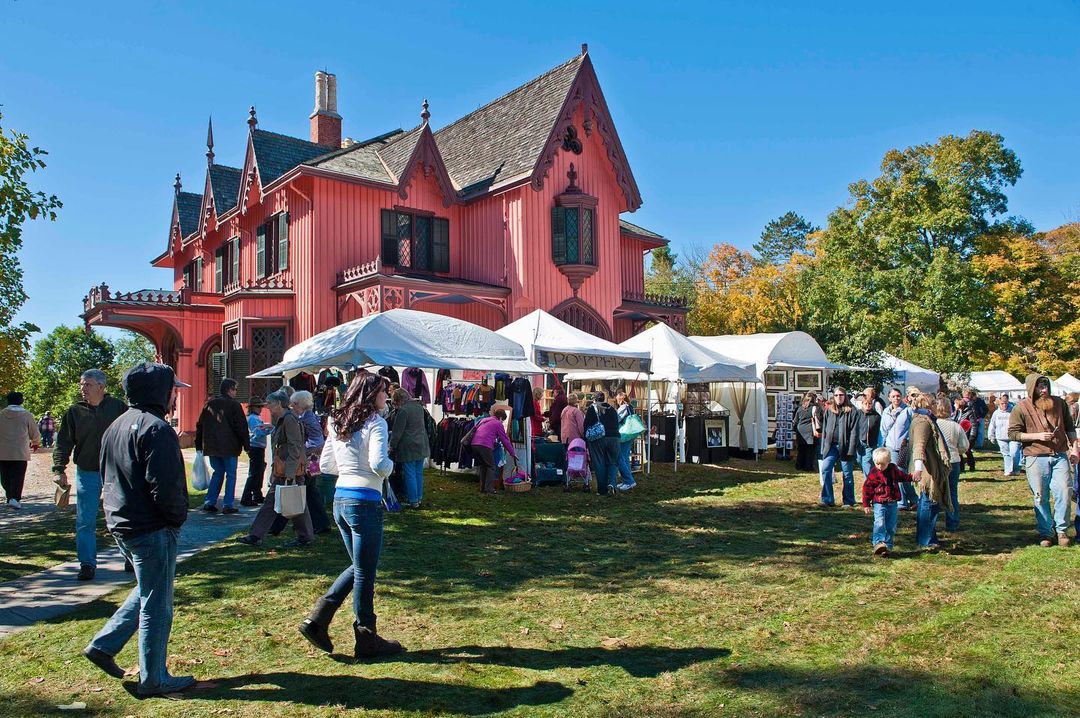
The travel and tourism industry is one of the largest and fastest growing industries in the world, with millions of people traveling for both leisure and business purposes every year. In order to grow market share in this highly competitive industry, businesses need to have a well-rounded marketing strategy that includes a strong public relations (PR) component.
Public relations can be an incredibly powerful tool for businesses in the travel and tourism industry, helping them to reach their target audience and increase brand awareness in a variety of ways. Here are some key ways that PR can be used to grow market share in this industry:
Media Coverage: One of the primary benefits of PR is that it can help businesses to secure media coverage, which can reach a large and diverse audience. By working with travel and tourism journalists and bloggers, businesses can generate positive media coverage that highlights their products, services, and unique selling points. This type of coverage can be especially valuable for small or niche travel and tourism businesses, as it can help them to stand out from their competitors and build brand awareness.
Influencer Marketing: Another effective way to reach potential customers in the travel and tourism industry is through influencer marketing. By partnering with travel bloggers, influencers, and social media personalities, businesses can tap into their large and engaged followings to promote their products and services. This type of marketing is especially effective for businesses that cater to specific niche markets, such as adventure travel, eco-tourism, or family travel.
Event Planning and Promotion: Another key aspect of PR in the travel and tourism industry is event planning and promotion. By hosting events such as travel trade shows, press trips, and product launches, businesses can generate media coverage and engage directly with potential customers. These events can be used to promote new products and services, build brand awareness, and establish relationships with key industry players and influencers.
Crisis Management: Despite the best planning, things can sometimes go wrong in the travel and tourism industry, whether it’s a natural disaster, a customer service issue, or a negative review. When this happens, it’s important to have a crisis management plan in place that will help you to quickly respond to the situation and mitigate any damage to your reputation. PR professionals can help businesses to develop and implement a crisis management plan, and they can also help to communicate with the media and public during a crisis situation.
Brand Storytelling: Finally, PR can also be used to help businesses in the travel and tourism industry to tell their brand story. By creating and sharing compelling narratives about the history, mission, and values of your business, you can build a deeper connection with your target audience and increase brand loyalty. This type of storytelling can be done through a variety of channels, including media interviews, press releases, and social media.
In conclusion, PR is a critical component of any marketing strategy for businesses in the travel and tourism industry. By using PR to secure media coverage, reach potential customers through influencer marketing, host events and product launches, manage crises, and tell their brand story, businesses can increase their brand awareness and grow their market share in this competitive and dynamic industry. Whether you’re a small or large business, PR can help you to achieve your marketing goals and reach your target audience in a way that is meaningful, impactful, and long-lasting.
Stay Tuned With Us
Stay informed, stay ahead: Join our newsletter for the latest updates, insights and invites.
TRENDING POSTS
Creating tiktok content to engage hospitality, food and beverage and tourism guests.
Discover how to captivate and connect with your hospitality, food and beverage, and tourism guests through irresistible TikTok content.
Using AI to Revolutionize Public Relations
Discover how the power of artificial intelligence is transforming the world of public relations.
Boston Man – George Regan Jr.: The Man in the Arena
Our own Founder and CEO, George Regan Jr. is a well-known and respected figure in
STAY IN THE KNOW
© 2023 Regan Communications Group. All rights reserved.
Public Relations in Tourism
- Living reference work entry
- Latest version View entry history
- First Online: 12 July 2023
- Cite this living reference work entry

- Assumpció Huertas 3
This is a preview of subscription content, log in via an institution to check access.
Access this chapter
Institutional subscriptions
Huertas, Assumpció. 2008. Public relations and tourism: Fighting for the role of public relations in tourism. Public Relations Review 34 (4): 406–408.
Article Google Scholar
Huertas, Assumpció, Andrea Oliveira, and Michele Girotto. 2020. Crisis communication management by the national tourist organizations of Spain and Italy in the face of Covid-19. El Profesional de la Información 29 (4): 1–18.
Google Scholar
Kent, Michael L., and Chaoyuan Li. 2020. Toward a normative social media theory for public relations. Public Relations Review 46 (1): 101857.
Kim, Jewoo, Jinhyun Jun, Eunkyoung Park, and Choong-Ki Lee. 2018. Investigating public relations as a destination promotion strategy: The role of multiple dimensions of publicity. Journal of Travel & Tourism Marketing 35 (5): 583–594.
L’Etang, Jacquie, Jesper Falkheimer, and Jairo Lugo. 2007. Public relations and tourism: Critical reflections and a research agenda. Public Relations Review 33 (1): 68–76.
Download references
Author information
Authors and affiliations.
Rovira i Virgili University, Tarragona, Spain
Assumpció Huertas
You can also search for this author in PubMed Google Scholar
Corresponding author
Correspondence to Assumpció Huertas .
Editor information
Editors and affiliations.
School of Hospitality Leadership, University of Wisconsin-Stout, Menomonie, WI, USA
Jafar Jafari
School of Hotel and Tourism Management, The Hong Kong Polytechnic University, Hong Kong, Hong Kong
Honggen Xiao
Section Editor information
Universidad Anáhuac México Campus Norte, Huixquilucan, Mexico
Francisco Madrid Flores
Rights and permissions
Reprints and permissions
Copyright information
© 2023 Springer Nature Switzerland AG
About this entry
Cite this entry.
Huertas, A. (2023). Public Relations in Tourism. In: Jafari, J., Xiao, H. (eds) Encyclopedia of Tourism. Springer, Cham. https://doi.org/10.1007/978-3-319-01669-6_154-2
Download citation
DOI : https://doi.org/10.1007/978-3-319-01669-6_154-2
Received : 29 January 2021
Accepted : 09 October 2022
Published : 12 July 2023
Publisher Name : Springer, Cham
Print ISBN : 978-3-319-01669-6
Online ISBN : 978-3-319-01669-6
eBook Packages : Springer Reference Business and Management Reference Module Humanities and Social Sciences Reference Module Business, Economics and Social Sciences
- Publish with us
Policies and ethics
Chapter history
DOI: https://doi.org/10.1007/978-3-319-01669-6_154-2
DOI: https://doi.org/10.1007/978-3-319-01669-6_154-1
- Find a journal
- Track your research

Travel PR: From Dreams to Destinations with a Travel PR Agency
Travel Public Relations, commonly known as Travel PR , is a vibrant and dynamic sector that elegantly blends the art of communication with the thrill of adventure.
This field is essential in the tourism industry as a pivotal link between travel brands and the world. It involves more than just traditional public relations; it’s about crafting and conveying captivating stories that echo the soul of travel destinations.
These stories are carefully tailored to ignite the wanderlust within travelers, urging them to embark on journeys to explore new and exciting destinations.
At its core, Travel PR is a strategic effort to build and nurture relationships between travel businesses and their potential clients. It’s about understanding the heartbeat of the tourism industry and communicating it in a way that resonates with the dreams and desires of travelers.
This communication takes various forms, from engaging media content that showcases the world’s most sought-after hotels and resorts to compelling narratives about hidden gems in remote corners of the globe.
The expertise of a Travel PR team is invaluable in this process. These professionals know how to navigate the complexities of the hospitality and tourism market, ensuring that their clients – be it a boutique property, a bustling city restaurant, or an exotic resort – are portrayed in the best possible light.
The target audience should be attracted to the brand identity and feel connected to their lifestyle and preferences.
Travel PR is about more than just promoting a destination or a property; it’s about creating an experience that begins long before the traveler sets foot in the location. It’s a nuanced blend of storytelling, marketing, and public relations that creates a compelling image of destinations and brands.
From managing media relationships to organizing press trips and handling social media, every aspect of Travel PR is geared towards making a place seen and felt by audiences worldwide.
In a world where the travel industry is constantly evolving, the role of Travel PR is more crucial than ever. It helps businesses in the travel sector stay relevant and desirable in a competitive market.
Whether it’s luxury resorts, independent hotels, airlines, or tourism boards, the ability of Travel PR to connect these entities with travelers, share their unique stories, and ultimately drive tourism and economic development is what makes this field not just important but indispensable.
Table of Contents
The Role of a Travel PR Agency

At its core, a travel PR agency is a specialized marketing agency that focuses on elevating the presence of travel and tourism brands in a crowded market.
These agencies have the expertise to navigate the complex landscape of travel media, building media relationships that transform boutique hotels, luxury resorts, and even entire destinations into brand advocates.
Consider, for instance, how a travel PR agency can turn an independent boutique hotel into a much-talked-about destination. These agencies give properties the limelight they deserve on the global stage through strategic media relations, compelling storytelling, and leveraging their vast network.
From creating buzz around a new restaurant in a luxury hotel to positioning a remote island resort as the next must-visit destination, travel PR agencies are the unsung heroes behind many travel stories that capture our imagination.
Travel PR isn’t just about putting a destination on the map; it’s about creating a narrative that embodies the essence of the place. It’s about making a restaurant not just a place to eat but a culinary journey. It’s about turning a stay at a hotel into a life-changing experience.
By harnessing their deep understanding of the tourism industry and their ability to craft compelling stories, travel PR agencies deliver results that matter – not just in bookings and economic development but in shaping the perception and appeal of travel destinations across the globe.
From airlines to luxury resorts and bustling cities to serene beaches, travel PR agencies work tirelessly to ensure that every story they tell is heard and felt. They create access to the world’s most enchanting places, weaving tales that invite travelers to embark on journeys they had only dreamed of. In a world where the way we travel and experience new destinations is constantly evolving, the role of a travel PR agency becomes even more pivotal.
They are the bridge between travel brands and the ever-curious traveler, a team dedicated to turning dreams into destinations.
The Cost of Dreams: Hiring a Travel PR Agency

Evaluating Investment and Returns in Travel PR
Embarking on the journey of hiring a travel PR agency raises a pivotal question: How much does it cost to hire a PR agent?
Like the diverse destinations we dream of, the answer varies, influenced by the scope of the project, the prestige of the agency, and the unique requirements of your travel brand or destination.
Investing in a travel PR agency is a significant step toward economic development and heightened brand recognition for independent boutique hotels or emerging destinations. The cost is more than a fee; it represents an investment in crafting a narrative that resonates with travelers across the globe.
With its unparalleled expertise and strong media relationships, a premier travel PR agency can transform boutique hotels into destinations that top every traveler’s wish list and turn lesser-known locales into the world’s must-visit spots.
When contemplating the cost, it’s crucial to recognize that your expenditure isn’t solely for public relations ; it’s an investment in brand advocates. These professionals strategically position your business in the competitive travel and tourism market . They create compelling stories that embody your brand’s identity and resonate with your target audience, delivering exceptional ROI.
A top-tier travel PR agency serves as a marketing agency, amplifying your presence in the tourism industry. It positions independent boutique hotels, luxury resorts, and even restaurants as prime travel destinations.
With a focus on hospitality and leveraging their media relationships, these agencies create compelling content for travel media, lifestyle magazines, and entertainment channels, ensuring your property gains access to a global audience.
The power of a proficient travel PR team lies in their expertise to weave stories about your business, whether hotels, airlines, restaurants, or entire destinations. They understand the importance of creating narratives that gain media attention and truly engage travelers and the industry at large.
Their strategies can be tailored to your specific needs, whether you’re looking to promote a boutique hotel, differentiate an airline in a crowded market, or showcase a new restaurant.
To select the best travel PR agency, finding a team that shares your brand’s vision and has the expertise to bring it to life is important. It’s selecting a partner that understands the intricacies of the travel industry and can transform your brand into a story that resonates across the globe.
This collaboration isn’t just a business transaction; it’s a journey toward creating lasting impressions and meaningful connections with travelers worldwide.
Finding the Right Fit: How to Find a PR Agent

Identifying Your Ideal Travel PR Partner
Selecting the ideal travel PR agency for your brand is a critical decision akin to choosing the perfect travel companion. Partnering with a team that comprehends your vision and is equipped to guide you toward your desired destination is essential.
In your quest for the right PR agent, prioritize finding a company renowned for its successful track record in travel and tourism PR.
This agency should understand the industry in-depth and maintain extensive media relationships across various platforms, including travel media, lifestyle magazines, and entertainment channels.
The caliber of a great travel PR agency isn’t solely reflected in their client list but in their storytelling prowess and capability to weave compelling narratives that truly encapsulate the essence of your brand. The team should embody a blend of hospitality, travel, and public relations expertise, ensuring a comprehensive approach to boost your brand’s presence in the market .
Whether representing a luxury resort on an isolated island, a vibrant city destination, or an airline striving for distinction in a saturated market, the right travel PR agency will grasp your unique position and formulate a customized strategy. They should adeptly translate the charm of your boutique hotel, the allure of your urban or rural destination, or the comfort and reliability of your airline into captivating stories. These narratives secure media access and resonate deeply with travelers globally.
In essence, the journey to finding the right travel PR agency involves seeking a partner who shares your vision and possesses the requisite expertise to actualize it. It’s about selecting a team that recognizes the subtleties of your specific market segment and can transform your brand into a story that echoes across the globe.
This partnership goes beyond mere business transactions; it’s about creating a synergy that turns your brand into a travel narrative that captivates and engages travelers, elevating your position in the competitive world of travel and tourism.
A successful collaboration with the right travel PR agency will position your brand as a market leader and serve as a catalyst for economic development. It’s about choosing brand advocates who understand the value of independent boutique hotels, luxury resorts, airlines, or even restaurants and can effectively communicate this to the world.
Through their expertise and strategic use of travel PR, marketing, and media relationships, they can deliver results that transcend traditional marketing approaches, making your brand a prominent name in the travel industry.
The Impact of PR on Tourism (Tourism PR)

Shaping Perceptions and Destinations
Public relations in tourism, often abbreviated as tourism PR, is the strategic communication that bridges travel brands and their audiences. In travel and tourism, PR is not just about disseminating information; it’s about creating a narrative that encapsulates the essence of a destination or a brand.
It’s a powerful economic development tool, helping boost tourism numbers and enhance the reputation of destinations and travel-related businesses.
The role of PR in this sector is exemplified by how a marketing agency can transform an independent boutique hotel from an unknown entity to a celebrated destination. Through effective travel media strategies and nurturing media relationships, these boutique hotels have become the talk of the town, drawing travelers from all corners of the globe.
Similarly, PR can elevate a local restaurant to an internationally recognized culinary hotspot or a quiet beach to a must-visit resort by weaving compelling stories that resonate with potential travelers.
Real-world examples abound. Consider how luxury resorts in secluded parts of the world gain global recognition or how certain destinations become synonymous with specific experiences, like adventure, luxury, or relaxation.
This is the power of travel PR – to deliver results that highlight a place or brand and create a desire to experience them firsthand.
The Life of a Travel Publicist

A Day in the Life: Crafting Travel Narratives
In tourism PR, a travel publicist stands as a pivotal figure. Their everyday life is an intricate tapestry of crafting and disseminating captivating stories about various travel-related brands, including destinations, hotels, airlines, boutique hotels, and more.
As the crucial bridge between their clients and the media, they play an integral role in shaping and maintaining the public image of these brands. This responsibility can significantly influence market perception.
A typical day for a travel publicist combines creativity and strategic planning. They are adept at identifying and highlighting the unique selling points of their clients’ offerings, whether it’s the exclusive experience at a luxury resort, the bespoke service of independent boutique hotels, or the innovative features of new airline services. Their expertise is tailoring these attributes into compelling narratives that resonate with travel media and potential travelers worldwide.
Their role extends beyond mere storytelling; it involves a comprehensive understanding of media relationships and public relations. Travel publicists are responsible for organizing press trips that showcase their clients’ properties or destinations, engaging with travel brands to create impactful marketing campaigns , and adeptly handling PR crises to safeguard their clients’ reputations.
Regarding compensation, travel publicists are remunerated for their expertise and contributions to the tourism industry. Their earnings can vary, with some being salaried travel PR agency employees while others working as freelancers or consultants. The value they add to the tourism and hospitality sectors is significant.
By transforming the essence of a travel brand into engaging and accessible stories, they open the doors to new markets and opportunities for economic development, solidifying their clients’ positions as reputable entities in the competitive tourism market.
The impact of a skilled travel publicist in the tourism industry is profound. They are the brand advocates who can captivate the imagination of travelers and the media, transforming destinations, hotels, and travel brands into renowned names and must-visit places on the global travel map.
Their role is essential in navigating the complex landscape of tourism PR, delivering results that resonate across the globe, and cementing the prestige of the world’s most sought-after travel destinations and services.
Building a Career in Travel PR

Pathways to Becoming a Travel PR Expert
For those with a passion for travel and a knack for storytelling, a career in travel public relations offers a world of opportunities. With a public relations degree, you can embark on a journey that lets you travel and become an integral part of the tourism industry.
A travel PR professional plays a pivotal role in shaping the image of travel brands, boutique hotels, luxury resorts, and entire destinations.
To become a travel PR professional, immerse yourself in tourism PR and hospitality. Gain experience in a marketing agency or within a PR team of a travel company. This will give you hands-on experience and help you understand the industry’s nuances. Building strong media relationships is key, as is developing an ability to craft and tell stories that resonate with travelers and the media.
Your expertise should be wider than just public relations; understanding the broader aspects of the travel industry, from economic development to the unique qualities of independent boutique hotels and airlines, is crucial. Networking and continuously updating your skills are also vital.
Being a part of a team that delivers results for clients in travel will require adaptability, creativity, and a deep understanding of global travel trends.
The Future of Travel PR

Innovations and Trends Shaping Travel Public Relations
As we look to the future, the field of travel PR is evolving with the introduction of new and innovative tools for tourism marketing. Digital media, social media platforms, and influencer marketing are becoming increasingly important in crafting and disseminating stories about destinations and travel brands.
Tourism and public relations objectives in the modern era are not just about promoting a destination or property. It’s about creating meaningful connections and experiences for travelers. It’s about showcasing each destination’s lifestyle, culture, and unique experiences. Travel PR professionals are tasked with selling a place and telling its story in an authentic, engaging, and immersive way.
Emerging PR tools are focusing more on personalized storytelling and targeted marketing. Using analytics to understand traveler preferences and trends is becoming more prevalent, allowing PR professionals to create more tailored and effective campaigns.
Additionally, the rise of sustainable and responsible travel is shaping the narratives and strategies in travel PR as travelers become more conscious of their impact on the destinations they visit.
In conclusion, the future of travel PR is vibrant and full of potential. For those aspiring to build a career in this field, it offers a chance to be at the forefront of shaping how the world views and experiences travel.
From working with boutique hotels to promoting entire regions, travel PR professionals are the architects of the travel stories that inspire us to explore the world.
Conclusion: The Journey Ahead

As we conclude this exploration into the dynamic world of travel public relations , it’s evident that PR plays an indispensable role in the travel industry. With its blend of storytelling, media relations, and strategic marketing, travel PR can transform hotels, resorts, destinations, and travel brands from mere names into experiences and dreams that travelers yearn for.
The importance of PR in this sector cannot be overstated. It is the force that propels destinations into the spotlight, turning them into places where travelers can create lifetime memories. From the bustling restaurants in vibrant cities to the serene luxury of remote resorts, the expertise of travel PR teams brings these experiences to life in the minds of potential travelers.
They are the storytellers who weave the narratives, the strategists who understand the market’s pulse, and the communicators who build lasting relationships between brands and clients.
Looking to the future, the landscape of travel PR is set to become even more exciting and influential. As the world becomes increasingly interconnected, the stories that travel PR professionals create will play a vital role in shaping the global perception of travel destinations and hospitality brands. The industry is evolving, with new markets emerging and travelers seeking more personalized, authentic, and sustainable experiences.
The future of travel PR lies in its ability to adapt, innovate, and continue telling compelling stories that resonate deeply with travelers worldwide. It’s about harnessing the power of digital media and emerging marketing tools while staying true to the essence of storytelling – creating connections and inspiring wanderlust.
In this journey, the role of travel PR will be more crucial than ever as it continues to shape how we view and experience the world. For businesses in the travel industry, collaborating with a skilled travel PR team is not just a strategy but a necessity in the ever-evolving world of tourism.
As we look forward, one thing is certain: the stories created by travel PR will continue to fuel our desire to explore, experience, and enjoy the wonders this world offers.
Commonly Asked Questions about Travel PR

What Does a Travel PR Do?
A travel PR professional is responsible for creating and promoting the image of travel brands, destinations, or properties. They craft compelling stories, manage media relationships, and strategize to enhance the visibility and appeal of their clients in the travel industry.
What is a Travel Publicist?
A travel publicist is a PR specialist focused on the travel sector. They work closely with travel media, plan promotional events , and use various public relations tools to boost the image and awareness of travel-related clients, from hotels and resorts to entire destinations.
Can Travel Agents Make 100K a Year?
Yes, travel agents can make 100K a year, especially with extensive experience, a strong client base, and specialization in lucrative travel niches.
What is Public Relations in Tourism?
Public relations in tourism involves managing tourism entities’ public image and reputation. It includes media relations, crisis communication, event management , and creating campaigns that positively influence public perception of a destination, hotel, or travel service.

Can You Travel with a Public Relations Degree?
Absolutely! A public relations degree opens up numerous opportunities in the travel industry, allowing you to work with various travel brands and destinations, often with the perk of traveling as part of the job.
What Does PR Stand for in Travel?
In travel, PR stands for Public Relations. It’s all about managing the reputation and public image of travel businesses and destinations, aiming to attract tourists and maintain a positive perception in the public eye.
What is the Role of PR in Travel and Tourism?
The role of PR in travel and tourism is to create a positive image for destinations, brands, or services. This involves crafting engaging stories, managing media relations, and creating marketing strategies that appeal to potential travelers.
What Does a PR Person Do in the Travel Industry?
A PR person develops and implements communication strategies in the travel industry to promote travel destinations or services. They handle media inquiries, organize press trips, and develop content highlighting their client’s unique products or services.
What are the PR Tools for Tourism?
PR tools for tourism include press releases, social media, influencer collaborations, content marketing, and events. These tools generate media coverage, engage audiences , and build a positive image for travel brands or destinations.
What are the Objectives of Tourism and Public Relations?
The primary objectives include:
Building a positive image.
Increasing awareness.
Managing public perception.
Ultimately, this drives interest and tourism to a destination or travel service.
How Do I Become a Travel PR?
To become a travel PR, obtain a degree in public relations or a related field. Gain experience in PR agencies and develop an understanding of the travel industry through internships and entry-level positions.
What is a Travel Agent’s Job?
A travel agent’s job is to plan and book client travel arrangements. They provide advice on destinations, arrange transportation and accommodations, and offer tailored travel experiences based on their client’s preferences.
Each question opens the door to the fascinating world of travel PR, where creativity, communication, and a passion for travel create inspiring and memorable experiences.
How Does a Marketing Agency Collaborate with Travel PR?
Marketing agencies and travel PR firms often collaborate to amplify a travel brand’s reach and impact.
While a travel PR agency focuses on building and maintaining a positive public image through media relations and storytelling, a marketing agency usually takes a broader approach, implementing various advertising and promotional strategies. This collaboration can be highly beneficial for travel brands, as it combines the strengths of both public relations and marketing.
For instance, a marketing agency might develop an advertising campaign to attract potential travelers, utilizing digital marketing , social media, and traditional advertising channels. Meanwhile, the travel PR team works to secure media coverage, arrange press trips, and manage communications that support these marketing efforts.
They work together to create a comprehensive strategy that enhances visibility and strengthens the brand’s reputation in the competitive travel market.
This synergy allows for a more integrated approach to promoting travel destinations, hotels, airlines, and other travel-related services.
By aligning the expertise of both marketing and PR professionals, travel brands can effectively reach their target audience, create compelling narratives, and ultimately drive more business and tourism to their destinations or services.

- Adventure Travel Marketing
- Tourism SEO
- Paid Search Marketing
- Tourism Content Marketing
- Tourism Website Design
- Reputation Management
- Social Media Marketing
- Total Online Opportunity Report
- Strategy First Package
- Jumpstart Package
- Catalyst Package
- Tourism Public Relations Program
- Insights Blog
- Case Studies
Guide to Tourism PR
Adventure Business , adventure marketing , Public Relations , Travel Marketing
0 comments
As we emerge from the pandemic, a key part of your tourism marketing should be public relations, as you seek to inspire your guests to travel again and experience your adventure tours and destination.
What is Tourism Public Relations?
When people ask, ‘what is tourism PR?’ I usually find it easier to explain what it’s not.
PR is not paying influencers to post about you; it’s not paying bloggers to blog about you or about creating the next viral video for Youtube or TikTok. Public Relations is getting traditional press, such as magazines, newspapers (online and offline), broadcast TV, radio, blogs and other online publications to do travel stories about your business and tours. It’s not pay-to-play, and you don’t have control over what gets published. It works like a ‘barter system’. You give something of value to a travel journalist, like a comp trip, or a great story idea, and they write about you.
Tourism PR is also known as ‘Earned Media’ because, well, you need to earn it.
Why do Tourism PR?
Tourism public relations resides at the top of the marketing funnel, in the ‘Awareness’ stage of the customer journey. Press is particularly important when you have a new tour offering or destination. Think about it: how could anybody search for your new trip on Google if they don’t know it exists? So if it’s brand new, and no one else is already doing it, you need some PR.
But when it comes to the customer journey, PR can also play a role at the ‘buy’ stage. If you’ve gotten some good press in the past, show that off on your website. A great story can really motivate a prospect to consider your tour over a competitor’s and also increase ‘trust’. After all, if a big publication like Outside or the NY Times has done a travel story on you, their clout will rub off on your business too.
PR is also one of the best ways to reach totally new markets. Does your road cycling tour take in unique local cuisines? Then maybe there’s a story that could appeal to a food writer, and a foodie publication.
PR has a big effect on your search engine optimization, or tourism SEO too. There are a lot of factors that Google uses to decide whether your website ranks on page one or page 10. If influential editorial websites , like Outside and the NY Times, (or even less well-known blogs), mention your tours and link to your site, that increases your Domain Authority and lifts up your website in search rankings.
So, as you can see, there are a lot of reasons to be doing tourism PR for your adventure travel business.
How to Get Started with Tourism Public Relations
You can’t just say to a travel journalist or editor, “Hey we’re the best, our tours are awesome. Come do a story on us!” First and foremost, it’s not about you, it’s about them and their readers. You must offer something of value if you expect to get press. That thing of value is a great story that will inspire, entertain or inform their readers.
So you need to find stories that sell.
Finding Your Best Travel Story
Always start with what you do, or in marketing speak, your ‘value proposition.’If you don’t know what that is, hire a tourism PR agency to help you find out. Basically, it’s your raison d’être, what you do that no one else does. It may just be strong enough to get you some press.
I once worked with a cat skiing lodge whose goal was to bring a level of 5-star service and refinement to a sport which was previously seen as lacking in both. This is what they did, and it was strong enough to create a story and get media coverage.
Become a Story Factory
I find many tourism business owners think only of their own niche when pitching media. For example, if they’re a ski lodge, they just want ski press. But here’s the thing, when we do customer research, we find fewer and fewer people reading those niche publications. Instead, we’ll see skiers, who are also business people, reading business publications. Or road cyclists reading lifestyle or fitness blogs.
So look beyond your niche and find stories that will appeal to your ideal clients, wherever they may be. The trick here is to look at your tourism business through as many different lenses as possible. Those different angles lead to different publications and new audiences for your tours.
Is there a Foodie Story?
Food and travel go together perfectly.
I can’t imagine going on a trip where the food wasn’t a factor. So look for food angles. For example, do your tours take in interesting local cuisines in your destination? Is there a local chef you work with who has a great backstory? Are there wine or craft beer or spirits angles? These all have their own niche writers and publications and they could tie in nicely with your core offering and let you reach new audiences.
Is there a Cultural Story?
People want to explore local cultures when they travel, to learn new customs, and hear other people’s stories. First Nations, indigenous cultures and even old world European cultures are of immense interest to travellers. So if you can find a strong story here, it will likely appeal to travel writers and editors.
Art and Architecture Stories
I’m thinking of certain high-end travel lifestyle magazines and most inflight magazines. There are a lot of architecture buffs out there, and if you do city tours, you should definitely be finding stories to tell around these subjects. The same goes for art.
And while those buildings and pieces of art may be hundreds of years old, there are always new stories to tell if you know where to look.
Historical Events and Major Anniversaries as Stories
Is there a major anniversary coming up in your destination? Can you find a tie-in that may be of interest for a journalist? If so, that could get you some good press.
A few years ago, Canada celebrated its 150th Anniversary. This was a major event coordinated from Destination Canada (The National tourism board) all the way down to regional DMOs and tour operators across the country. Travel media from around the world were invited and the press generated is still paying dividends.
Current Events and News Stories
Do you ever notice how many stories you see about the Olympics in Olympic years? Some are so tangential that you wonder how they have anything to do with them. Some famous downhill skier trained here one winter when he was 9? Well, that’s an Olympic story!
But seriously, when there are major world events, like the World Cup, Olympics or even holidays like Valentines Day or Christmas, writers and editors are looking for stories on these for their readers. Ever notice that every Valentine’s Day, there’s some crazy, romantic package or product in the news that is so over-the-top, no one will ever actually buy it? Well, that’s not the point. They’ve got a good PR agency, and now they’ve got tons of press.
Popular Culture Stories
Many years ago, when I was working as a travel journalist and the Lord of the Rings trilogy was taking off, I came across a bike tour company that was doing rides around some of the film locations in New Zealand. I managed to get assignments from several editors and with the support of Tourism New Zealand, travelled there to do the story.
Film locations, settings for famous books, or TV shows can all be great story angles to pitch.
Trends are King for Travel Media
But of all the story angles out there, one trumps them all. Trends. Editors love trends. They are literally catnip for media. Is there something going on in your niche, a major change you’re seeing on the horizon? Can you position yourself or one of your staff as an expert on this new phenomena? If so, that’s your strongest story by a longshot. Find the next ‘green travel’ or ‘farm to table’ trend and you’ll be getting more press that you can imagine.
These are just some of the angles that can work well for finding your stories. But don’t limit yourself. There are many more story angles waiting to be found.
How to Pitch Travel Media
Ok, now that you’ve found your story, you’ll need to package it into a pitch that’s strong enough to not get buried in a journalist’s inbox alongside those hundreds of others that never got read. If writing is not your strongest skill, hire a PR consultant or a writer for some help. Your pitches MUST be extremely well written.
Here I like to use the SUCCESS method, popularized by Chip and Dan Heath in their excellent marketing book, Made to Stick . Grab a copy. And as you can guess, it’s an acronym.
Simple: Keep your pitches stupid simple. If it’s a big, complicated, convoluted idea, ditch it.
Unexpected: Editors want to be surprised. So don’t tell them something they already know. Look for the novel, and unique, not routine and boring.
Concrete: Make things tangible. If something is 37,892 sq kms that doesn’t mean anything. Tell me it’s half the size of Scotland, and now I understand how big it is.
Credentialed: This is an important one. Editors have amazing BS detectors. ‘Biggest, best, most amazing’ etc are guaranteed to get your pitch deleted instantly, unless you can back them up. ‘Best beach according to Tripadvisor’, that could work. Claims, facts, and figures must have sources cited.
Emotional: Find the human interest angle. You don’t need to pitch a tear-jerker, but a bit of emotion goes a long way with editors.
Story: Try to weave a story into your pitch. Think about characters, problems and resolutions.
Short: Keep it to the point, or it won’t even be read. I suggest no more than one or two paragraphs and 500 words. If you can’t get it done with that amount, keep cutting it until you can.
Use the SUCCESS method like a checklist for any pitches you’re writing. You don’t have to hit them all, but the more you can cover, the better.
Finding Travel Media to Pitch
Now that you’ve got your awesome pitch, or better yet ‘pitches’, you need to find travel media to pitch them to.
Create a list of publications in your niche and related ones. Then look at who’s writing the articles most relevant for your tourism business, by finding their bylines. From there, search the publication’s website for their contact info or email, and failing that look for them on LinkedIn or Google. If you can find an email address, that’s the best way to pitch. I’d never pitch on Linkedin or Twitter or any other social media platform. Do the same thing for editors. Pitch them too, but in general I’d expect a better response rate from journalists than editors.
I also suggest setting up Google Alerts for your niche, for example ‘fly fishing’ if you’re a fly fishing lodge and a few other related keywords. You’ll get daily notifications of what publications and journalists are covering your tourism niche. You may even discover some totally new, highly relevant publications here. Add these to your list.
Now that you’ve got a decent sized list, it’s time to get to work. Pitching media is hard work. It takes time and perseverance, reaching out individually. But one well-crafted, targeted pitch is more valuable than a 1000 blanket press releases any day. In fact, I don’t recommend using press releases at all.
What Are You Offering Travel Media?
When you’re pitching travel media you need to be upfront on what you’re offering. Is it just a great story idea that may be of interest to that publication’s readers? If so, that’s fine. Or are you offering to host a travel journalist on a FAM? (industry lingo for ‘familiarization’ or press trip). If you are hosting, what can you offer and what do you expect in return? Can you host just a writer, or a writer/photographer pair? If you only have space for a writer, do you have pro quality images available for them?
For most tourism businesses, I suggest using your shoulder season for hosting travel media. You want the journalist to have a great experience and nice weather, but you don’t want to turn away paying guests to host them. FAM trips can be for individual journalists or for groups of media (more common with DMOs) and should be part of your tourism Public Relations program. Here’s where you and your staff can really shine and show a journalist why you deserve that great press.
Working with DMOs and Travel Industry Partners
Travel journalists don’t make a lot of money and their publications will seldom foot the bill for their travel expenses. So even if you’re offering them a comp trip, there’re still airline tickets, hotels, rental cars and other expenses that will need to be taken care of. The more of those you can help with, the more appealing your FAM will be to a journalist.
Here’s where working with local industry partners and your Destination Marketing Organization (DMO) can really help. Many DMOs and tourism boards have marketing budgets for supporting travel media. This may include flights and even some of their other trip expenses. It really depends on your DMO, their mandate, and budget. Here, relationship building is key. Make those contacts with your local tourism leaders, and let them know how you’re supporting their destination (not just your business).
If there’s no money for supporting media, your DMO may still be able to help by rounding up local support. For example, a local hotel can offer a few nights comp, and some restaurants can host a few meals. I’ve seen many cash-strapped destinations put together really good on-the-ground media support. But keep in mind most of those partners will want something in return, like a mention in the story, so make sure the journalist knows that.
Most DMOs also have their own media lists and attend conferences and trade shows to pitch journalists on their destination. If you’re doing great work, they’d probably be happy to promote you. This can be a really good way to leverage your pitching and reach media you might not have otherwise had access to. Again, building those relationships with your DMO is key, and supplying them with your great pitches and letting them know you’re open to doing FAMs will go a long way.
Make PR a Part of your Tourism Marketing Plan
As you can tell, if you’ve read this far, there’s a lot involved in getting press for your tourism business, but if you take the time to do these things and commit to setting aside time every week, your PR will grow exponentially, and ultimately so will your bookings.
If you need any help, our team has years of experience working with travel media in several different tourism niches and have generated press in top level publications around the world.
Contact us to schedule an appointment.
You may also like
Trends in tourism marketing for 2024, resort marketing, leave a reply.
Your email address will not be published. Required fields are marked
Get The Latest Insights And Trends In Tourism Marketing & PR Delivered Straight To Your Inbox Each Month
Your privacy is important. We will never sell or share your contact info. Our privacy policy .
5W Public Relations: 5W PR Blog
Public Relations Insights from Top PR Firm 5W Public Relations
- PR Strategy
The Role of PR in the Tourism Industry

The tourism industry relies heavily on public relations to communicate with the public, gain promotion, and attract visitors. Tourism is a form of business, and like any business it needs to reach out to its audience. Public relations helps tourism businesses attract visitors by developing positive relationships with the local community and the media.
Public relations is crucial to the success of a tourism business because it creates awareness of a specific destination, attraction, or event. This form of communication allows the tourism industry to raise its profile within the local community and target market areas.
The main purpose of public relations is to build positive relationships that will generate interest in tourism related businesses. Many tourist attractions rely heavily on word-of-mouth advertising, which is created through effective public relations campaigns and marketing strategies.
A large part of public relations for the tourism industry is promoting an attraction or destination’s image to potential tourists. Public relations for tourism can be used for marketing, advertising, promotions and sales. It can also be used as a tool for crisis management when something goes wrong or there are negative events that affect travel plans.
Here’s how PR can help:
- It helps boost awareness of a destination’s unique qualities
- It also helps visitors learn about an area’s offerings before they arrive
- It helps manage expectations so that there are fewer frustrating surprises
- It helps destinations provide consistent messaging across multiple platforms
Why Public Relations is Essential
PR helps to build, manage and sustain the image of destinations in the tourism industry. This industry is characterized by a reliance on images; therefore an accurate picture of what is offered must be painted.
Public relations also allows brands to create a relationship with customers . This is important because it makes the development of both long-term and short-term marketing strategies possible. This usually has the effect of making a destination appear more attractive.
PR is all about perception, and the perception of a destination by a potential visitor is absolutely crucial to tourism. If a destination has a bad reputation, people will stay away; It’s that simple. PR is important for every community that wants to increase its tourism and hospitality business.
A community that has endured a recent crisis such as a hurricane, a flood, an economic collapse, or a negative news story about crime will likely see tourism revenue dry up for months if something’s not done about it. Below are some ways public relations can help:
- Let people know the situation is under control
- Let the world know how the community is recovering
- Showcase how the destination has become even better than before
In this age, PR has become crucial to a tourism board’s success, and it can help large areas like a city or state bring in more visitors. PR helps to establish a positive image for a location while promoting activities, attractions, restaurants and events, which will naturally lead to an increase in visitors. Tourism PR should focus on the following:
- Promoting what the destination has to offer
- Advising travel media about the destination
- Booking travel media visits
- Developing relationships with travel media
- Convincing travelers that the destination is a must-go location
More PR Insights

Best PR Tactics for Consumer Technologies

Build a PR Plan For Haircare Brands

Here’s Why Paid Memberships are a Strategic PR Move
- Skip to content

Wish You Were Here: A Glimpse Into the World of Tourism PR
Published on January 24, 2023, at 11:03 a.m. by Lauren Barnes.
There is a broad range of industries that a public relations practitioner can delve into — one of them being travel and tourism PR. Any city, regardless of its size, needs to maintain the relationship with its target audience, just like any public figure, brand or corporation. Public relations establishes a positive reputation, as well as promotes things to do, which “will naturally lead to an increase in visitors,” according to 5W PR .
For major cities such as Nashville or Atlanta, there are enough attractions to bring in crowds on their own. However, small towns across America gain a substantial economic boost from the tourism industry. This naturally raises the question: What is it like to be a public relations practitioner for a small town?
Three experienced PR practitioners gave their insights on what makes travel and tourism public relations stand out as well as some industry best practices.
Does your team do a lot of research to define your audience?
Matthew Maxey, director of public relations for Visit Franklin, said there is “quite a bit of research” when formulating the profile of a typical Franklin, Tennessee, visitor. With the help of external strategic communication companies, research is compiled from credit card and hotel data. Maxey said that messaging is then crafted with the visitor profile in mind, and that marketing is focused on areas where most of Franklin’s visitors originate.

Ally Dorrough, communications and marketing specialist for Gulf Shores & Orange Beach Tourism, agreed that a great deal of research goes into identifying her target audience. “Our marketing/communication department leads the research efforts determining audiences,” said Dorrough. According to a study on its website, Gulf Shores & Orange Beach Tourism also partners with a data analysis company to utilize surveys that identify common characteristics in visitors.
Maxey characterized his main audiences as leisure travelers, conventions, business bureaus and government funders. He said leisure travelers plan vacations and read travel and leisure magazines — they are the type of audience that comes to mind when someone thinks of tourism PR. Convention and business bureau representatives read trade publications and are motivated to fill conferences with attendees. If PR practitioners market their destination as a convention venue, they gain the opportunity to convert incoming business travelers into leisure travelers. Government funders are composed of government leaders, stakeholders and the local community.
Dorrough placed her organization’s primary publics into three categories: 1) sports and event planners/event rights holders, participants, sports families and event-goers; 2) meeting planners who are already planning meetings in the market (repeat business) and meeting planners who could potentially plan a meeting in the market (new business), a public similar to Maxey’s convention and business bureau representatives; and 3) international tour operators and international receptive operators. In layman’s terms, these are a sort of travel agent. PR practitioners maintain relationships with them so they will promote their destination to their clientele.
What goes into branding for a town?
“A lot, if done properly, can go into branding a town. It goes back to storytelling and using proper ethos,” said Maxey. He described the process of narrowing hundreds of words down to what embodies the town best and then weaving that message into released content, such as commercials and photography.
Nikki Tyler, former marketing director for Peachtree City, Georgia, noted that when looking to rebrand, PR practitioners should take surveys and “hear what the people have to say.”
Are there any events your city hosts or do you promote a compiled calendar?
How involved a PR practitioner would be in their town’s events varies depending on the location. For Visit Franklin, Maxey said his team promotes the calendar of events but does not have a hand in their organization. For Gulf Shores & Orange Beach Tourism, Dorrough said her involvement ranges depending on the type of event.
“On the leisure side of our business, we strictly promote events taking place in Gulf Shores and Orange Beach through various avenues depending on the events and post them [on our calendar],” Dorrough explained. “On the sports and events side, we facilitate 120+ sports and major leisure events per year. These events are a mixture of events we own and operate, events we hold the contract for, events we provide grant funding to, and the list goes on.”
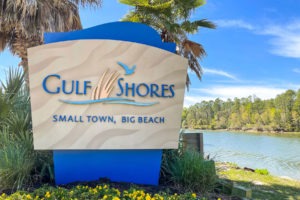
Tyler noted that some towns, such as Peachtree City, “create events to market them.” She explained that holding events provides opportunities for social media content, as well as generating online content with a high search engine optimization (SEO) “for when potential visitors look online for what to do this weekend.” Event planning and promotion depends on location and organization; this distinction is notable for students interested in tourism PR.
What was one of your favorite campaigns you ran?
Tyler spoke about a monthly event called Night Market that Peachtree City holds. Night Market features live music, art vendors, craft drinks and food trucks; the event was inspired by international outdoor markets and is a popular social gathering for locals and visitors alike. “Night Market came when I was redoing our website. Peachtree City didn’t have anything to do at night, so we needed something to talk about,” Tyler said.
“I’m most fond of when the whole city rallied around the Fuller Story Project. Like many other Southern towns, Franklin has a statue of Confederate soldiers, but the African American story wasn’t being told. Pastors and local historians got together to create markers to tell the missing stories and put up the first statues dedicated to U.S. Colored Troops,” said Maxey. “It was personally satisfying to get a feature story in the New York Times that Franklin is a Southern town doing things differently.”
“I had a big hand in rebranding our sports commission to become Gulf Shores l Orange Beach Sports & Events. It was a great process to walk through what a successful rebrand looks like,” said Dorrough. “Another project which won me the PRSA Bronze Anvil award was our meeting planner toolkit . It includes marketing tools for planners to plan and promote meetings.”
What makes tourism PR unique?
“We are usually in the good news business,” said Maxey, who has previously worked in both sports and political science PR. He said it is the relationship aspect that sets tourism PR apart. Maxey commented that travel and tourism journalists are generally friendlier and that the best interviews are conversational, such as when Maxey can tell the story of Franklin and include its many features, rather than push one product.
Tyler said that travel and tourism PR is unique because the product is unique. She emphasized that “every city is different,” so cities must customize their messaging.
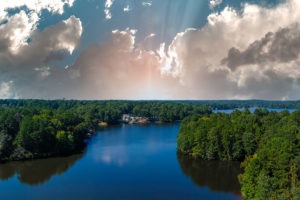
“It’s an unexpected area of PR. What’s special is that we help people discover amazing experiences,” said Dorrough. “The people I’ve met are awesome professionals who work day in and day out to travel and make memories that last a lifetime.”
What is your favorite part of tourism PR?
Tyler said she loves traveling to new places, because on her return, she sees what she took for granted in a new light. She noted that travel and tourism PR is a field that can be done anywhere, since cities all over utilize public relations.
Dorrough said that travel and tourism PR has “the fun people” and mentioned the benefits of working in a destination. Despite travel and tourism crises such as natural disasters or the pandemic, communities are “bouncing back even better and welcoming those families back,” said Dorrough. “It all comes back to relationships. Research and relationships — that is our calling card.”
What would you recommend to students who would like to get into tourism PR?
There are a multitude of ways students can gain professional advice or experience. “Go to your local Convention and Visitor Bureau and ask to help,” said Tyler. “Offer to be a marketing assistant and help with the content calendar or write copy. Once you have experience, surrounding cities will have job openings and [you can] work your way up.”
Dorrough emphasized the benefit of talking with industry professionals and internships. “It’s neat when students can discover other industries outside agencies and corporations,” said Dorrough. “I wish I’d known more about tourism PR in college.”
Maxey agreed about the value of internships. He also mentioned getting journalism experience because “it helps to know where [journalists] are coming from.”
“As a general rule of PR, be a decent human,” said Maxey. “Our role is to make it as easy as possible to tell the story about the destination.”
Travel and tourism public relations is a great opportunity for public relations students who would like to work in an out-of-the-box environment. The field incorporates data and best practices such as content calendars and press releases, with the addition of the excitement and positivity that come with the travel and tourism industry culture.
You may also like

What is Thought Leadership?

Cultivating Connections Changes Lives: A Kristen Ellis Profile

Public affairs specialists and PR services for the travel and tourism sector with GlobalCom
GlobalCom PR Network has been working successfully with clients for more than 15 years. Our global PR network comprises some 80 expert agencies that can provide public relations services for the travel and tourism industry in over 100 countries worldwide, whether it’s large scale PR campaigns or policy makers.
Use the adjacent form to get in touch with us about your travel and tourism PR campaign and we will get back to you in no time.
Full Name (required)
Your Email (required)
Your Message
Your Organization (required)
URL/web address (required)
Targeted Countries (required)
Estimated Budget
I have read the Privacy Policy note. I agree that my details will be collected for contacting and answering.
Truly Global
Renowned PR agencies
PR experts from all over the world
We also offer public relations expertise in these areas:
The network
- PR Services & Expertise
- Markets & Industries
- Our Network
- Our Partners & Consultants
- GlobalCom Annual Summit
Regions we cover
- Asia Pacific (APAC)
- Latin America
- Middle East & Africa
- North America
Information
- Legal Disclosure
- Privacy Statement
Focus Industries
- Automotive PR
- Aviation / Aerospace PR
- Consumer Tech PR
- Energy & Cleantech PR
- Financial & FinTech PR
- Food and Drink PR
- Healthcare PR
- International PR
- Technology PR
- Entertainment PR
- Consumer & Lifestyle
- Industrial & Manufacturing PR
- Public Sector PR & Government
- Startups & Scaleups
- Travel & Tourism
Our Services
- Crisis Communications
- Media Relations
- Influencer Marketing
- Analyst Relations
- Search Engine Optimisation
- Market Research
- Content Marketing
- Employer Branding
Change Your View
Pr, social + experiential.
Our personalized service, strategy and creativity connect media, consumers and influencers across the globe, taking people to new places and changing their view for the better.
In 2020 we were awarded the prestigious HSMAI Adrian Award Best of Show in PR for our work on the National World War II Museum's 75th Anniversary of D-Day campaign. In 2021 we were awarded three Gold Best Practice awards, HSMAI's highest honor of the year for our work to create “Buy One, Give One,” a campaign designed to jump-start future travel bookings while also donating much-needed vacations to frontline medical workers, in addition to integrated recovery campaigns for clients Costa Rica Tourism and The British Virgin Islands.
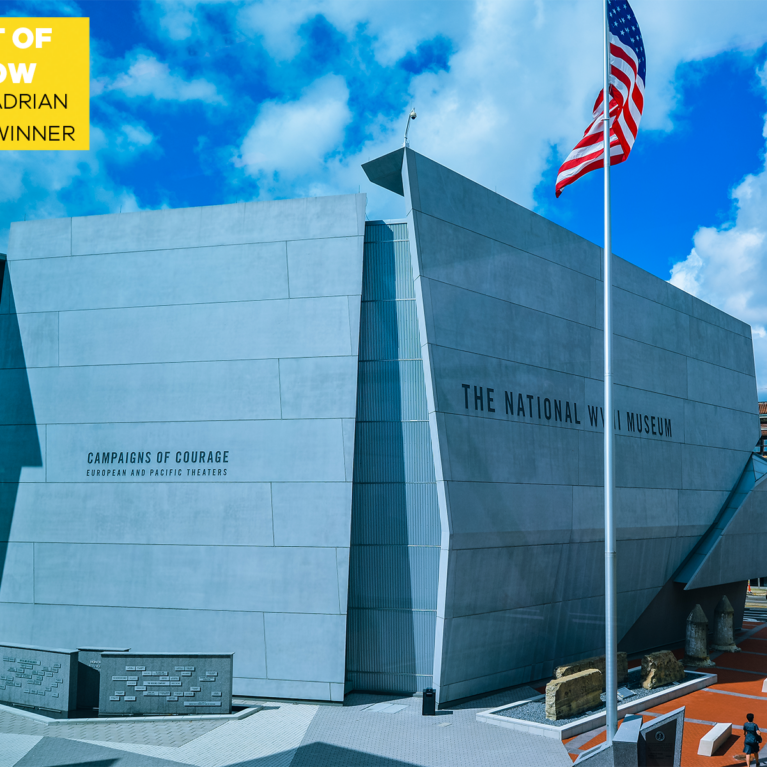
Owning an Entire News Cycle: D-Day with The National WWII Museum
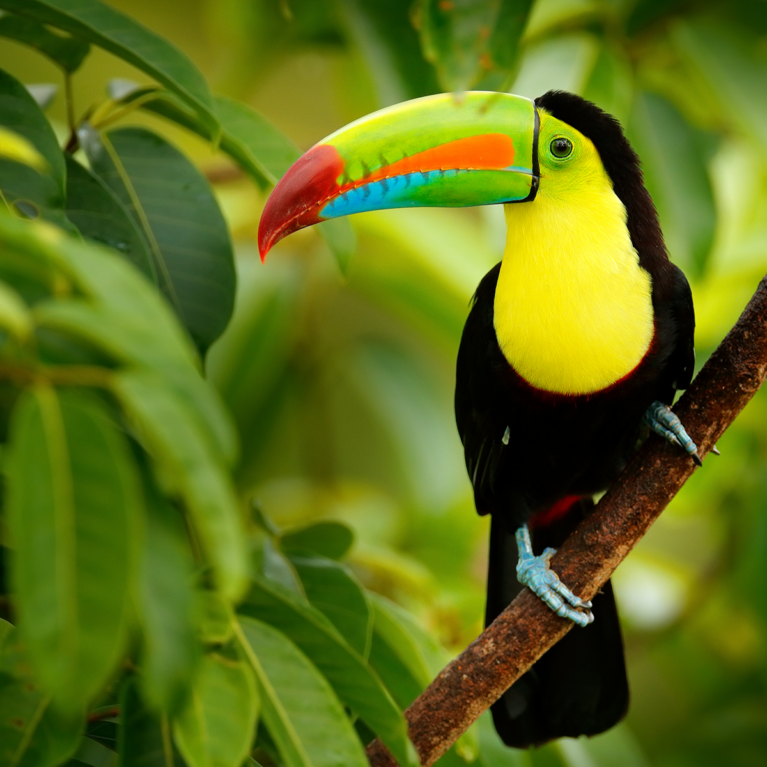
Promoting the Pura Vida Experience
Trusted to tell their stories.
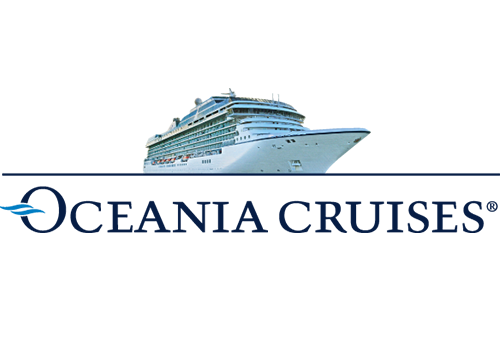
- The results are beyond my highest expectations. Rob Citino on CBS This Morning & making A1 of The New York Times the same day is something I'll never forget. Jonah Langenbeck, CMO, The National WWII Museum
- Seriously! I have never, ever had a new development get this type of coverage in my 20 years! Well done NJF. Bravo!!! Phones and email are blowing up here!" Corcoran Sunshine Marketing Group on behalf of iStar
- NJF has elevated our PR profile to phenomenal new heights. For public relations, there are only three letters you need to know – N, J and F. Timothy E. Rubacky, Oceania Cruises
- The team at NJF is always on the lookout for new PR opportunities to maximize our brand exposure. They are not only an agency, but an extension of our team. Nadine Koszler, Eurail
- NJF is a wonderful partner and delivers repeatedly with some of the largest names in travel media such as Condé Nast, Travel and Leisure and USA Today. Former CMO, Rhode Island Commerce Corporation
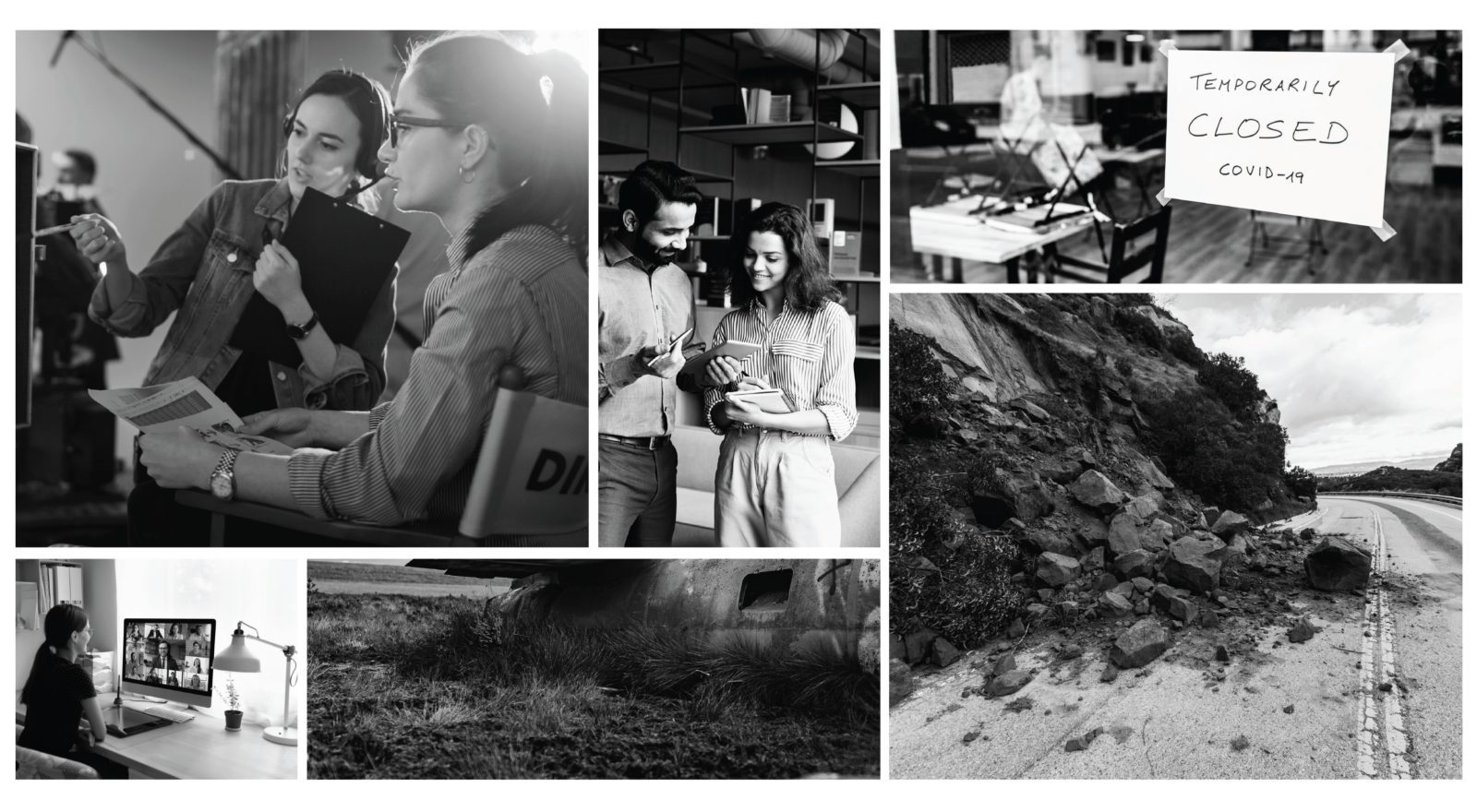
Hire us and we'll make news together.
Join a company where work can take you places.
- Follow Along
- Name This field is for validation purposes and should be left unchanged.

Pine Knoll Lodge & Cabins
Public Relations In Travel And Tourism
Public relations (PR) is the process of managing the spread of information between an organization and the public. In the travel and tourism industry, effective PR can be the difference between a successful company and one that struggles to attract customers.
There are many ways to approach PR in the travel and tourism industry. Some companies focus on advertising, while others rely on public relations to get the word out. No matter what approach you take, there are a few key things to remember.
First, always target your audience. When creating PR materials, make sure you know who your audience is and what they want to hear. This will help you create content that is relevant and interesting to them.
Second, be sure to stay up to date on current events. The travel and tourism industry is constantly changing, so it’s important to be aware of new developments. By being up to date, you can ensure that your PR materials are relevant and timely.
Finally, be sure to measure your results. PR is not a one-time effort, it’s an ongoing process. By measuring your results, you can determine whether or not your efforts are achieving the desired results.
The travel and tourism industry is a competitive one, and effective PR can be the difference between success and failure. By following the above tips, you can create PR materials that will help your company stand out from the competition.
- 1 What is public relations in tourism?
- 2 How are public relations used in the travel and tourism industry?
- 3 What are the 4 types of public relations?
- 4 What is the role of PR in hospitality industry?
- 5 How important are public relations and publicity to tourism and hospitality organizations?
- 6 What are the principles of public relations?
- 7 What are examples of public relations?
What is public relations in tourism?
Public relations (PR) is the process of managing the spread of information between an organization and the public. In tourism, PR is the process of managing the spread of information between an organization and its customers, as well as between an organization and the media.
There are many different aspects to PR in tourism. One of the most important is building and maintaining a good relationship with the media. PR professionals in tourism must be able to understand and communicate the unique aspects of their industry in a way that appeals to journalists. They must also be able to respond quickly to media inquiries, and be prepared to deal with any negative publicity.
Another important aspect of PR in tourism is customer relations. PR professionals must be able to create and maintain positive relationships with customers, and respond to any complaints or problems quickly and effectively. They must also be able to create and distribute marketing materials that will appeal to customers and encourage them to visit the destination.
Overall, PR in tourism is an essential part of any successful tourism organization. It is responsible for creating and maintaining a positive image for the organization, and ensuring that the right messages are getting out to the right people.
How are public relations used in the travel and tourism industry?
Public relations are an important part of the travel and tourism industry. They are used to promote and market destinations, attractions, and businesses. PR can also be used to manage the image of an organization and to build relationships with the media.
There are a number of different ways that PR can be used in the travel and tourism industry. One way is to create a marketing campaign. PR can be used to create a marketing campaign for a destination, an attraction, or a business. The campaign can include advertising, public relations, and social media.
PR can also be used to manage the image of an organization. Organizations in the travel and tourism industry can use PR to manage the image of their company, their brand, and their products. They can also use PR to respond to negative publicity.
PR can also be used to build relationships with the media. Organizations in the travel and tourism industry can use PR to build relationships with the media in order to get positive publicity. They can also use PR to respond to negative media coverage.
Public relations is an important part of the travel and tourism industry. It can be used to create marketing campaigns, to manage the image of an organization, and to build relationships with the media.
What are the 4 types of public relations?
Public relations (PR) is the practice of managing the spread of information between an organization and the public. There are four main types of PR:
1. Traditional PR: This is the most traditional form of PR, and involves working with the media to get your organization’s message out to the public.
2. Social Media PR: This involves using social media platforms to spread your organization’s message.
3. Event PR: This involves organizing and promoting events to promote your organization.
4. Crisis PR: This involves managing and responding to crises that occur within your organization.
What is the role of PR in hospitality industry?
Public relations (PR) is a strategic communication process that builds mutually beneficial relationships between organizations and their publics. In the hospitality industry, PR is essential for promoting a company, its brands and its products.
There are many different ways that PR can benefit a hospitality company. For example, PR can help to build awareness of a brand or product, create a positive image for the company, generate publicity for events or promotions, and build relationships with key stakeholders.
PR can also be used to manage crisis situations. In the event of a crisis, PR can help to minimize the damage to the company’s reputation and to protect and restore the trust of its customers.
Overall, PR is an essential tool for promoting a hospitality company and its brands. By creating positive relationships with the public, PR can help to build a strong foundation for success.
How important are public relations and publicity to tourism and hospitality organizations?
Public relations and publicity are extremely important to tourism and hospitality organizations. They are responsible for creating and managing the organization’s image and reputation. They also promote the organization to potential customers and partners.
Public relations (PR) is the process of managing the organization’s image and reputation. PR professionals develop and execute communications strategies that promote the organization’s goals and objectives. They work with the media to create positive stories about the organization, and they also work with customers and partners to build positive relationships.
Publicity is a type of marketing that involves getting the organization’s name and message out to the public. Publicity professionals create and distribute press releases, pitch stories to the media, and work with bloggers and social media influencers. They also create marketing materials such as brochures, website content, and social media posts.
Public relations and publicity are important for several reasons. First, they help to build trust and credibility for the organization. Second, they generate awareness of the organization and its products and services. And third, they help to generate leads and sales.
Public relations and publicity are essential for tourism and hospitality organizations. They help to create a positive image for the organization, and they help to promote its products and services to the public. PR and publicity are important for building trust and credibility, generating awareness, and generating leads and sales.
What are the principles of public relations?
Public relations (PR) is the practice of managing the spread of information between an organization and the public. It is usually divided into two branches: corporate PR and public affairs. Corporate PR is the management of an organization’s reputation and image, while public affairs is the management of government relations.
There are several basic principles of PR that are essential to its success. The first is truthfulness. The public must be able to trust that the information they receive from an organization is truthful and accurate. Second is transparency. Organizations must be open and honest about their activities, and be willing to share information with the public. Third is timeliness. Information must be released in a timely manner, so that the public can understand it and act on it. Fourth is accessibility. Organizations must make sure that information is available in a variety of formats and accessible to the public. And finally, relevance. Information must be relevant to the public, and meet their needs.
Public relations is a critical part of any organization, and following these principles is essential to its success.
What are examples of public relations?
Public relations (PR) is the process of managing the spread of information between an organization and the public. It is the practice of managing communication between an organization and its publics, which can include customers, employees, shareholders, the media, and the general public.
There are a number of different ways an organization can use public relations. Some of the most common include:
-Issuing press releases
-Holding press conferences
-Creating marketing materials
-Developing and executing public relations campaigns
-Engaging in social media marketing
Public relations can be an extremely valuable tool for organizations. It can help them build and maintain a positive image, improve communication with the public, and achieve their marketing and business objectives.
Related Posts
Zurich to zermatt swiss travel pass, zodiac sign most likely to travel.
Puerto Rico Tourism Company
As part of the requirements of Act 272, you must register as an innkeeper and request and innkeeper ID number from PRTC. You can obtain the registration at the Puerto Rico Tourism Company’s Tax Division office located in Old San Juan.
The following properties are subject to the room occupancy tax:
- Other short-term (less than 90 consecutive days) rental properties
Do you rent a property for less than 90 days?
If so, you are subject to the dispositions of Act Num. 272 of September 9, 2003 known as the Room Occupancy Tax Law.
Whenever you rent your property on a short-term basis (less than 90 consecutive days), you must charge your guests a room occupancy tax equal to 7% of the room’s rate and submit it to the Puerto Rico Tourism Company (PRTC).
How to submit your tax
After registering as an innkeeper, and collecting the room tax, you must submit a Monthly Tax Declaration by or prior to the 10th day of the following month after.
The Room Occupancy Tax monthly declarations can be submitted at any Scotiabank Puerto Rico branch, at the Puerto Rico Tourism Company’s Tax Division, or online at: https://roomtax.tourism.pr.gov .
You can also submit it by postal mail to: Puerto Rico Tourism Company Room Tax Division PO Box 9024000 San Juan, PR 00902-4000
Request Room Tax Exemption
RoomTax Exemption Request Form
Related Documents
- Act 272 (in Spanish)
- Download the Frequently Asked Questions document (in Spanish)
- Innkeeper registration application form
- Instructions to register in RoomTax application service
- Instructions to complete the monthly tax declaration form (in Spanish)
- Monthly room occupancy tax declaration form
- Press Newsletter & Action Plan AF-20-003 (in Spanish)
If owners fail to comply with the Monthly Tax Declarations or the payment corresponding to the Room Occupancy Tax, they can be subject to penalties, administrative fines and the permanent revocation of promotional benefits and concessions of economic incentives, if any, provided by the Puerto Rico Tourism Company.
Those who do not comply with the dispositions of Act Num. 272 could face fines of $500 for each day of infraction, up to a maximum of $25,000, amount that must be paid as part of the taxes in addition to any other penalty, late fees or interests applicable as stipulated by the law.
For more information about the Room Occupancy Tax Cannon and the dispositions of Act 272 of September 9, 2003, please call (787) 289-1716, (787) 289-1717, (787) 289-1718.
Surge in Adventure Tourism: Four Big Trends in 2024
Jesse Chase-Lubitz , Skift
April 17th, 2024 at 12:00 PM EDT
New data shows that experiences are the leading factor when choosing a destination.
Jesse Chase-Lubitz
The latest consumer spending data from GetYourGuide reveals a surge in demand for unique travel experiences and activities that align with personal passions.
The report analyzes booking data from millions of travelers and highlights a significant shift in travel priorities. Here are the key takeaways:
Experiences Rule
Travelers are prioritizing experiences over traditional sightseeing. Nearly all travelers (90%) plan to spend the same or more on activities in 2024, and experiences are now the leading factor when choosing a destination (reported by 98% of travelers).
Passion Drives Destinations
The hottest travel destinations are no longer just about iconic landmarks. Cities like Fajardo, Puerto Rico (up 419% in bookings by American travelers) and Hoi An, Vietnam (up 284% globally) are experiencing a boom, likely due to their unique cultural offerings and adventure opportunities.
Globally Inspired
Travelers are venturing beyond the usual suspects. This year’s top trending tours include the Sagrada Familia in Barcelona, kayaking through El Yunque Rainforest in Puerto Rico, and even a hot air balloon ride over Interlaken, Switzerland.
The Rise of the Explorer
GetYourGuide identifies a new breed of traveler – the “Explorer” – who spends more on experiences, takes longer trips, and travels more frequently. These high-value vacationers are fueling the experience economy.
Get Skift Research
Skift Research products provide deep analysis, data, and expert research on the companies and trends that are shaping the future of travel.
Have a confidential tip for Skift? Get in touch
Tags: getyourguide , tourism , Travel Experiences , Travel Trends
Photo credit: GetYourGuide Walking Tour in London. Source: GetYourGuide

- Press Release Pricing
- Submit Press Release
- Press Release Distribution
- Recent News
- News by Category
- News by US Region
- News by Country
- RSS News Feeds
- Business News
- Lifestyle News
- Public Interest News
- Technology News
- Become a Publishing Partner
- For Journalists
- Business Directory
- Products & Services
- Post Your Profile
- Join Now Sign In
Tourism.co.th Unveils Thailand.org, Ushering in a New Chapter for Thailand's Tourism
Tourism.co.th has officially launched Thailand.org, a new initiative aimed at promoting sustainable and authentic tourism in Thailand. This platform focuses on supporting local communities and eco-friendly practices, enhancing the cultural experience for tourists.

- Acceso a la información
- Misión y Visión
- Junta de Directores
- Equipo de trabajo
- Informe Anual 2021
- Annual Report 2021
- Desde la red
- Noticias CPI
- Cómo solicitar documentos públicos
- Directorio de Oficiales de Información de agencias gubernamentales
- Directorio de Oficiales de Información municipales
- Ley de Transparencia, Ley 141 de 2019
- Informe de cumplimiento con la Ley 141
- Guía de Solicitud de Información Pública
- Herramientas para periodistas
- Talleres 2014
- Talleres 2015
- Eventos 2015
- Talleres Ambientales 2016
- Contáctenos
Caribbean Resorts and Tourism Operators Pay a High Price for Sargassum
- April 11, 2024

Suzanne Carlson | The Virgin Islands Daily News

Rafael Díaz | Centro de Periodismo Investigativo
The 2023 sargassum season started early at the Bolongo Bay Beach Resort on St. Thomas in the United States Virgin Islands.
Around the end of March, staff launched the response system they have devised over the years in the absence of any official guidance from the government: hand-raking the beaches and spreading the seaweed to dry on the grounds of the 65-room property, which is nestled in a cove on the southern side of the island of about 50,000 people.
As usual, the family-owned resort had to foot the full bill for the response.
It is not alone. Without a national sargassum management strategy or a dedicated pool of funding from the V.I. government, the financial burden for cleaning the shorelines in the territory has often fallen squarely on resorts, yacht charterers and other tourism operators.
“We’re in the millions of dollars being spent on mitigation over the last decade,” said Lisa Hamilton, President of the V.I. Hotel and Tourism Association.
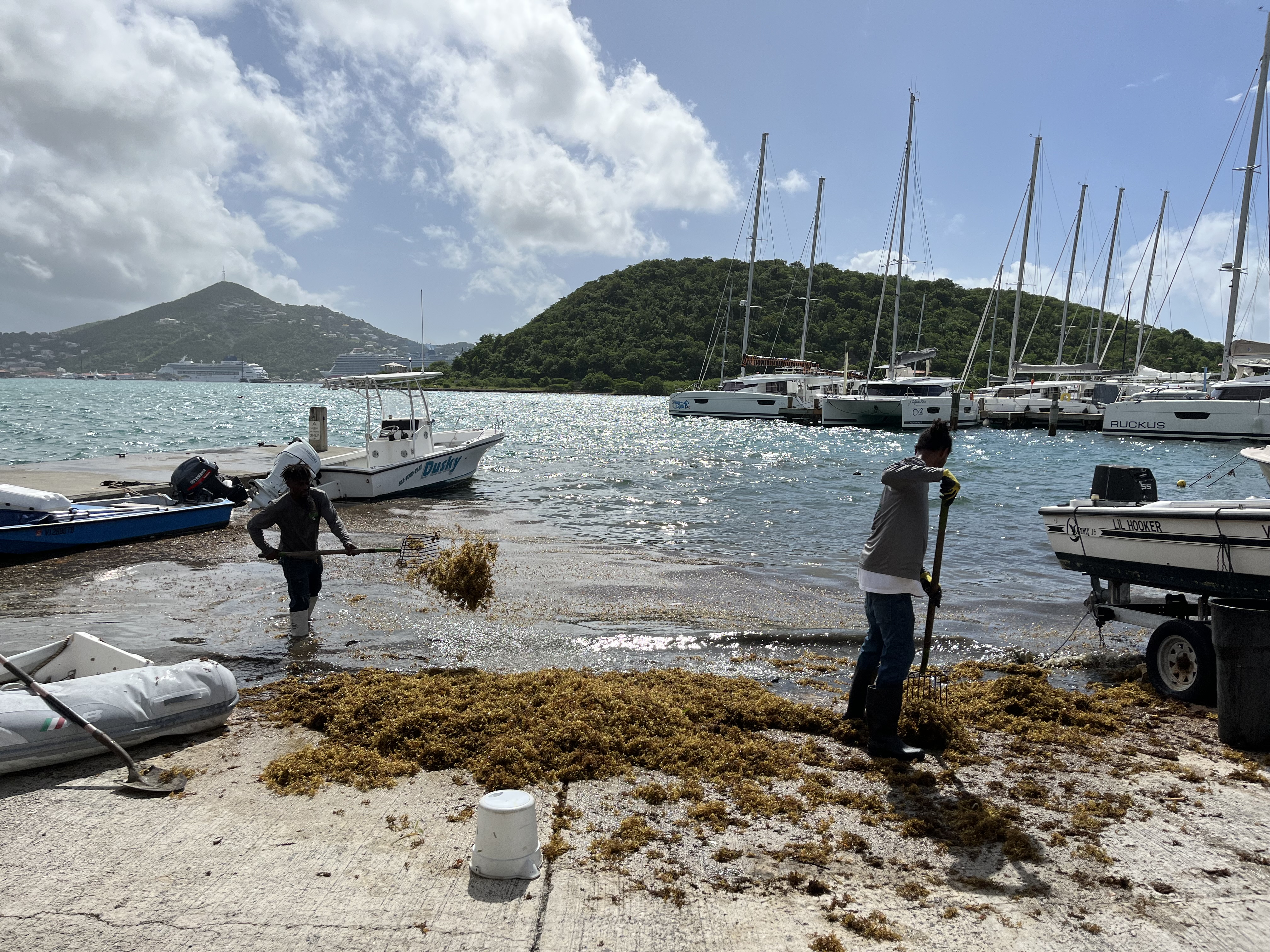
Workers with ORB Landscaping and Trucking use rakes and bins to haul massive piles of sargassum away from the Frenchtown boat ramp on St. Thomas on Oct. 20, 2023. They were called in for “emergency cleanup by the government.” Photo by Suzanne Carlson | The Virgin Islands Daily News
Often these costs come on top of lost revenue as tourists increasingly select their vacation destinations to avoid affected beaches.
Variations of this scenario have played out repeatedly across the Caribbean since sargassum began to regularly swamp the region in 2011.
For example, tourism operators in Aguadilla, Puerto Rico, were among the 2023 victims. Last September, the municipality — which had been spared from major sargassum events in the past — was hit by its first major influx shortly after Hurricane Lee passed to the north in September. As a result, tourism virtually shut down on the popular Aguadilla beaches of Peña Blanca and Crash Boat for about a week, Centro de Periodismo Investigativo (CPI) found.
“When people come [to the beach] and see that and [smell] the odor, they go to other beaches,” resident James Ramos said while he cooked the popular barbecue chicken “pincho” skewers that he sells daily on Crash Boat beach. “This was one of the worst [sargassum events] I have ever seen.”
Without a government mitigation plan mandated by April 2023 but never produced, Aguadilla business owners worked to clear the seaweed themselves. But they said they had questions about how to respond, with no clear guidelines on its disposal and no government program to reimburse them for their lost earnings.

In Puerto Rico, James Ramos said that the arrival of sargassum kept people away from the beach where he has a business selling “pinchos”. Photo by Gabriel López Albarrán | Centro de Periodismo Investigativo
The Puerto Rico Department of Natural and Environmental Resources (DRNA for its initials in Spanish) was ordered to prepare a mitigation plan for the management of sargassum under a law signed in January 2023 by Governor Pedro Pierluisi.
But that plan, which should have been ready by the start of April 2023, has stalled partly for lack of funding, said Mariana León Pérez, a researcher in marine and coastal sciences who was involved in the project’s early stages.
In its place, the DRNA recently published an updated and expanded action protocol for the management of sargassum that it initially created in 2015. But the protocol did not answer all the questions facing the affected Aguadilla businesses, whose struggles also point to larger issues about jurisdiction between the federal and local governments in the U.S. territory, according to León Pérez.
“[It is necessary] to clarify the jurisdiction; which permits are needed in terms of disposal of sargassum on land. That remains pending,” she explained. “We are already quite clear about what process must be followed to request permits for removal, but after you remove it, what do you do with it? So we have to clarify the disposition and use part.”
Aguadilla Mayor Julio Roldán said such issues presented a problem during the September accumulation.
“There were some people who own dairy farms who wanted to have sargassum, because it is a good protein for cows, but obviously they were not clear if that could be done or not. Since it was not specific in the [DRNA] protocol, it could not be achieved,” Roldán told the CPI.
“How bad is the sargassum?”
Studies have shown that Caribbean tourism drops by 7% to 35% during times of sargassum accumulation, and roughly 55% of all hotels in the region report being affected by sargassum, according to Dominican Republic-based oceanographer Elena Martinez.
Cleanup efforts — frequently funded by tourism properties desperate to keep their guests happy — often involve the use of heavy machinery on beaches. But this process exacerbates erosion, resulting in the need to invest additional millions of dollars in erosion restoration, said Martinez, who works as the research and development lead at SOS Carbon, an organization that designs systems to collect sargassum before it reaches shorelines.
Though total cleanup costs are unknown, they have been estimated to reach as high as $210 million in a single year in the Caribbean — a number the some researchers believe to be an underestimate.
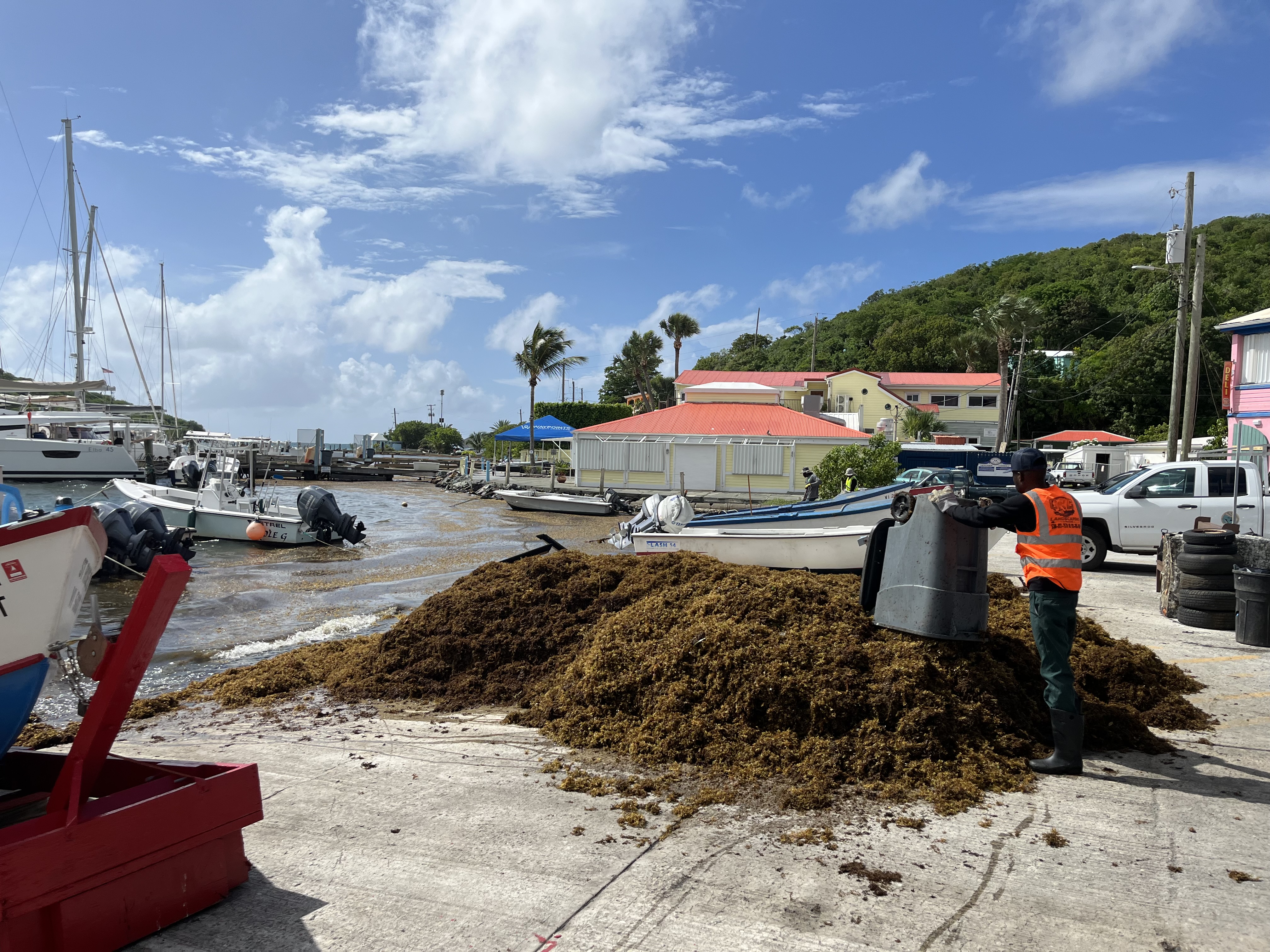
A worker piles up sargassum at the Frenchtown boat ramp on St. Thomas in the U.S. Virgin Islands on Oct. 20, 2023, after a late-season influx of seaweed that filled Charlotte Amalie Harbor, making it difficult for boats to navigate the busy port. Photo by Suzanne Carlson | The Virgin Islands Daily News
Meanwhile, tourists planning a Caribbean vacation have been asking variations of the same question on travel websites and social media: “How bad is the sargassum?”
While several satellite tracking maps are available online, predicting where exactly an influx will occur is still challenging: Sargassum movements vary widely based on wind direction, currents, and other factors.
As a result, vacation planners have taken to social media to crowdsource answers to specific questions about where and when sargassum might hit. Also stoking travellers’ concerns are media reports, like a recent USA Today headline that warned, “A record-size blanket of smelly seaweed could ruin your spring beach trip. What to know.”
“Sargassum has a palpable effect on our tourism product and the people involved in the industry,” Dona Regis-Prosper, Secretary-General of the Caribbean Tourism Organization (CTO), told CPI. “When it’s heavy, our destinations suffer vacation cancellations and beachfront room closures, leading to staff layoffs and reduced economic gain for the sector and associated communities. Therefore, the sargassum invasion has had a negative impact on the tourist industry, the region’s main economic driver.”
Sargassum is more than just a nuisance, and can be associated with potentially serious health impacts. An April 18, 2023 air pollution alert in Capesterre de Marie-Galante in Guadeloupe warned vulnerable people to stay away from the coast, as the smell of decomposing sargassum made the air difficult to breathe. At times, such incidents have kept tourists away from the village and forced businesses to close.
Another wave of sargassum in Guadeloupe in September affected a populated marina with a variety of hotels, restaurants, and businesses offering water activities.
Last year in Jamaica, the popular tourist town of Negril experienced one of its worst sargassum seasons, which caused serious issues for beachfront hotels forced to spend thousands of Jamaican dollars to clean the beaches daily.
In the British Virgin Islands, the popular Nanny Cay Marina has tried using boats’ propellers to clear out the seaweed clogging its docks — a method that worked but proved expensive as gasoline costs mounted.
“Cleanup costs are prohibitive, with several destinations spending millions to restore the sociological and economic balance of affected areas,” said Regis-Prosper. “Kudos must be extended to those who have undertaken this challenging task and made strides toward recovery.”

A boom holds sargassum back from yachts at Nanny Cay Resort and Marina in the British Virgin Islands on June 17, 2023. Photo by Freeman Rogers | The BVI Beacon
She added that the CTO “applauds the efforts of organisations that are searching for and funding educational and start-up initiatives dedicated to repurposing sargassum to benefit our destinations. We will continue to encourage researchers, marine scientists, entrepreneurs and innovators to explore imaginative ways and means of managing sargassum by using it for carbon sequestration, agricultural use, and biofuel, for example.”
$25,000 per day
Until a large-scale solution is found, costs will likely continue climbing for tourism properties. In the U.S. Virgin Islands, no full spending breakdown has been made public, but a government official said in 2022 that the territory’s hotels collectively spent around $25,000 a day to clean up sargassum during major influxes.
Other numbers emerged during a public hearing in 2021, when environmental consultant Amy Dempsey said that the 264-room Margaritaville Vacation Club spends around $50,000 a month to remove sargassum, while the 180-room Ritz-Carlton spends more than $500,000 a year and removes as many as six 40-yard bins of sargassum in a day.
“Economically, for places like Margaritaville and a lot of the hotels on east-facing beaches, it is a major cost for them, the sargassum removal,” said Paul Jobsis, Director of the Center for Marine and Environmental Science at the University of the Virgin Islands. “And of course their guests don’t like it because it doesn’t feel good when you go swimming in a bunch of sargassum.”
This investigation is the result of a fellowship awarded by the Center for Investigative Journalism’s Training Institute and was made possible in part with the support of Open Society Foundations .



IMAGES
COMMENTS
Public relations in the travel and tourism industry is not just about adding hype to your product, getting online visibility, and so on. Instead, PR helps provide value that goes beyond just the promotion of your company or business. In the travel industry, the benefits of PR are huge. It helps companies gain more market penetration, create ...
PR can help to build a positive brand image by highlighting the unique features, experiences and offerings of a specific destination or travel brand. 8. Crisis management. The tourism and travel industry isn't all roses. As with any other company, brands in the sector are vulnerable to crises, such as. natural disasters.
One of the primary roles of Public Relations (PR) in tourism is to build awareness about a particular destination or attraction. This involves creating media releases, organizing press trips for journalists and influencers, and maintaining relationships with key media outlets. Media Releases: PR professionals write and distribute media releases ...
The Puerto Rico Tourism Company (PRTC), founded in 1970, is a public corporation responsible for stimulating, promoting, and regulating the development of Puerto Rico's tourism industry. 2 Paseo La Princesa, San Juan, PR 00902 Phone: (787) 721-2400 Email: [email protected]
Puerto Rico has been through a lot - storms, disease, quakes. ... Despite all its challenges, Puerto Rico set a tourism record in 2021, and it remains a prime place to visit in 2022.
Tourism in Puerto Rico attracts millions of visitors each year, with more than 5.1 million passengers arriving at the Luis Muñoz Marín International Airport in 2022 (a 6.5% increase from 2021), the main point of arrival into the island of Puerto Rico. With a $8.9 billion revenue in 2022 (a 39% increase over the previous high in 2019), tourism has been a very important source of revenue for ...
Karyl Leigh Barnes is the President of the Tourism Practice at Development Counsellors International (DCI). Since entering the tourism and hospitality industry 25 years ago, she has worked to promote destinations on every continent but Antarctica. In the past 60 years, DCI has helped more than 500 destinations world-wide increase visitor ...
In conclusion, PR is a critical component of any marketing strategy for businesses in the travel and tourism industry. By using PR to secure media coverage, reach potential customers through influencer marketing, host events and product launches, manage crises, and tell their brand story, businesses can increase their brand awareness and grow ...
The benefits of tourism PR are manyfold. A great story can inspire your target audience and PR is often regarded as one of the best top-of-the-funnel ways of raising awareness about your business or tours. But it also has value further down the customer journey, and can motivate a booking-ready customer to choose your company over a competitor ...
Digital communication has also facilitated the implementation of public relations in the tourism industry. Social media are important public relations tools (Kent and Li 2020) that facilitate word-of-mouth, tourist reviews, and engagement with tourists.However, technological evolution continues in the tourism industry and smart technologies (Internet of Things, fifth generation mobile network ...
Puerto Rico is full of people who are welcoming and buena gente (which is Boricua lingo for kind and friendly). Here, you'll feel like family instead of just a visitor. Discover vibrant cultural experiences, a celebration of life, and a captivating rhythm around every corner. Let us be the first to say ¡ bienvenidos!
The Role of a Travel PR Agency. At its core, a travel PR agency is a specialized marketing agency that focuses on elevating the presence of travel and tourism brands in a crowded market.. These agencies have the expertise to navigate the complex landscape of travel media, building media relationships that transform boutique hotels, luxury resorts, and even entire destinations into brand advocates.
Tourism PR is also known as 'Earned Media' because, well, you need to earn it. PR is both online and offline editorial coverage that creates awareness for your tourism business. Why do Tourism PR? Tourism public relations resides at the top of the marketing funnel, in the 'Awareness' stage of the customer journey. Press is particularly ...
Puerto Rico's "Live Boricua" campaign has helped revitalize tourism. The #CoverTheProgress campaign generated 14.5 million media impressions and laid the groundwork for three back-to-back years of ...
The Role of PR in the Tourism Industry. The tourism industry relies heavily on public relations to communicate with the public, gain promotion, and attract visitors. Tourism is a form of business, and like any business it needs to reach out to its audience. Public relations helps tourism businesses attract visitors by developing positive ...
Published on January 24, 2023, at 11:03 a.m. by Lauren Barnes. There is a broad range of industries that a public relations practitioner can delve into — one of them being travel and tourism PR. Any city, regardless of its size, needs to maintain the relationship with its target audience, just like any public figure, brand or corporation.
GlobalCom PR Networks has PR teams specialising in tourism and travelling services including hotels, airlines, online travel portals and tourism agencies. They have excellent contacts with the travelling and tourism media. They have the expertise to create compelling messaging to reach any target group anywhere in the world. Who are our clients.
NJF is an industry leading, full-service pr agency specializing in travel, tourism, and hospitality. Visit our website and learn more about our award-winning PR and marketing strategies. ... In 2020 we were awarded the prestigious HSMAI Adrian Award Best of Show in PR for our work on the National World War II Museum's 75th Anniversary of D-Day ...
SAN JUAN, Puerto Rico, Jan. 31, 2023 /PRNewswire/ -- On National Plan for Vacation Day, Discover Puerto Rico, the Island's official Destination Marketing Organization (DMO), shares the 2022 record ...
Public relations (PR) is the process of managing the spread of information between an organization and the public. In the travel and tourism industry, effective PR can be the difference between a successful company and one that struggles to attract customers. There are many ways to approach PR in the travel and tourism industry. Some.
The Puerto Rico Tourism Company (PRTC), founded in 1970, is a public corporation responsible for stimulating, promoting, and regulating the development of Puerto Rico's tourism industry. 2 Paseo La Princesa, San Juan, PR 00902 Phone: (787) 721-2400 Email: [email protected]
The Puerto Rico Tourism Company (PRTC), founded in 1970, is a public corporation responsible for stimulating, promoting, and regulating the development of Puerto Rico's tourism industry. 2 Paseo La Princesa, San Juan, PR 00902
Surge in Adventure Tourism: Four Big Trends in 2024. Jesse Chase-Lubitz, Skift. April 17th, 2024 at 12:00 PM EDT. Skift Take. ... kayaking through El Yunque Rainforest in Puerto Rico, and even a ...
Cruise tourism reached 107% of 2019 levels in 2023, with 31.7 million passengers sailing - almost two million more than 2019. ... PR Newswire Distribution Helpline 888-776-0942
Bangkok, Thailand, April 10, 2024 ---- Tourism.co.th, a prominent non-governmental tourism agency, is excited to announce the debut of its latest project, Thailand.org. This innovative platform is ...
For example, tourism operators in Aguadilla, Puerto Rico, were among the 2023 victims. Last September, the municipality — which had been spared from major sargassum events in the past — was hit by its first major influx shortly after Hurricane Lee passed to the north in September. As a result, tourism virtually shut down on the popular ...
Findings reveal that the increase in educational tourism in Famagusta caused the indigenous Cypriots to move into suburban neighbourhoods. Factors including urbanization issues, social issues, economic issues, cultural issues, and environmental issues were revealed to be the most challenging issues resulting in community displacement.